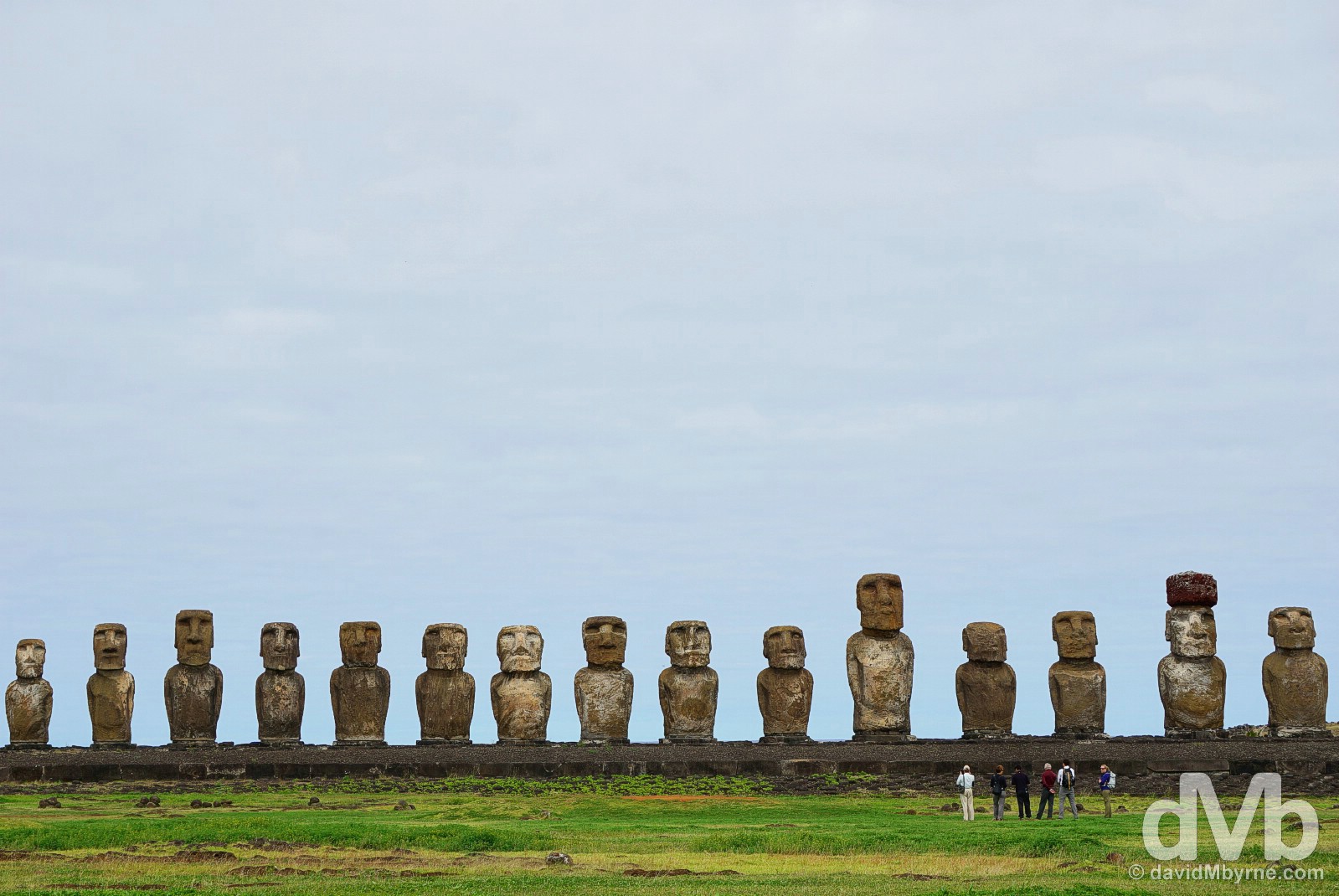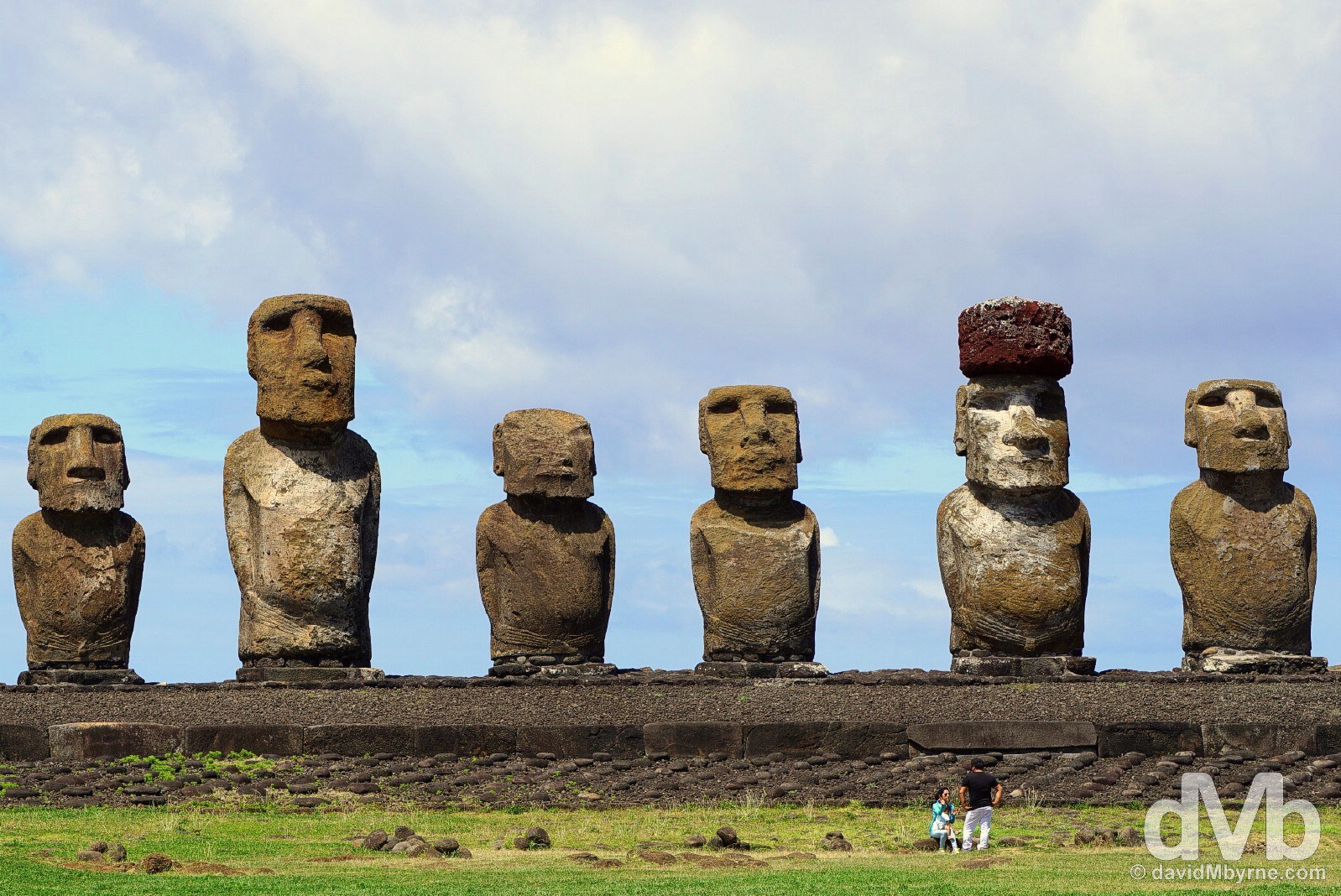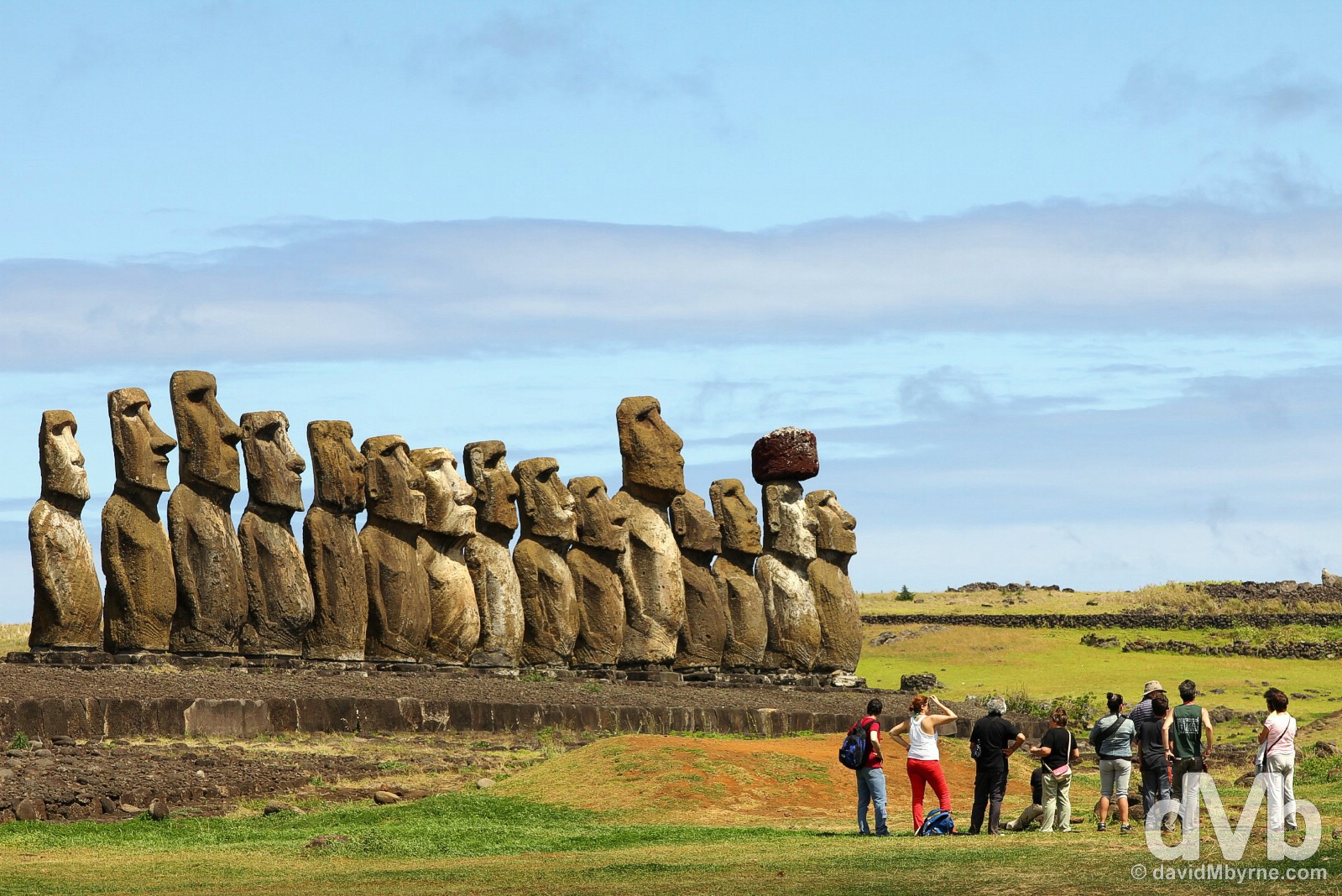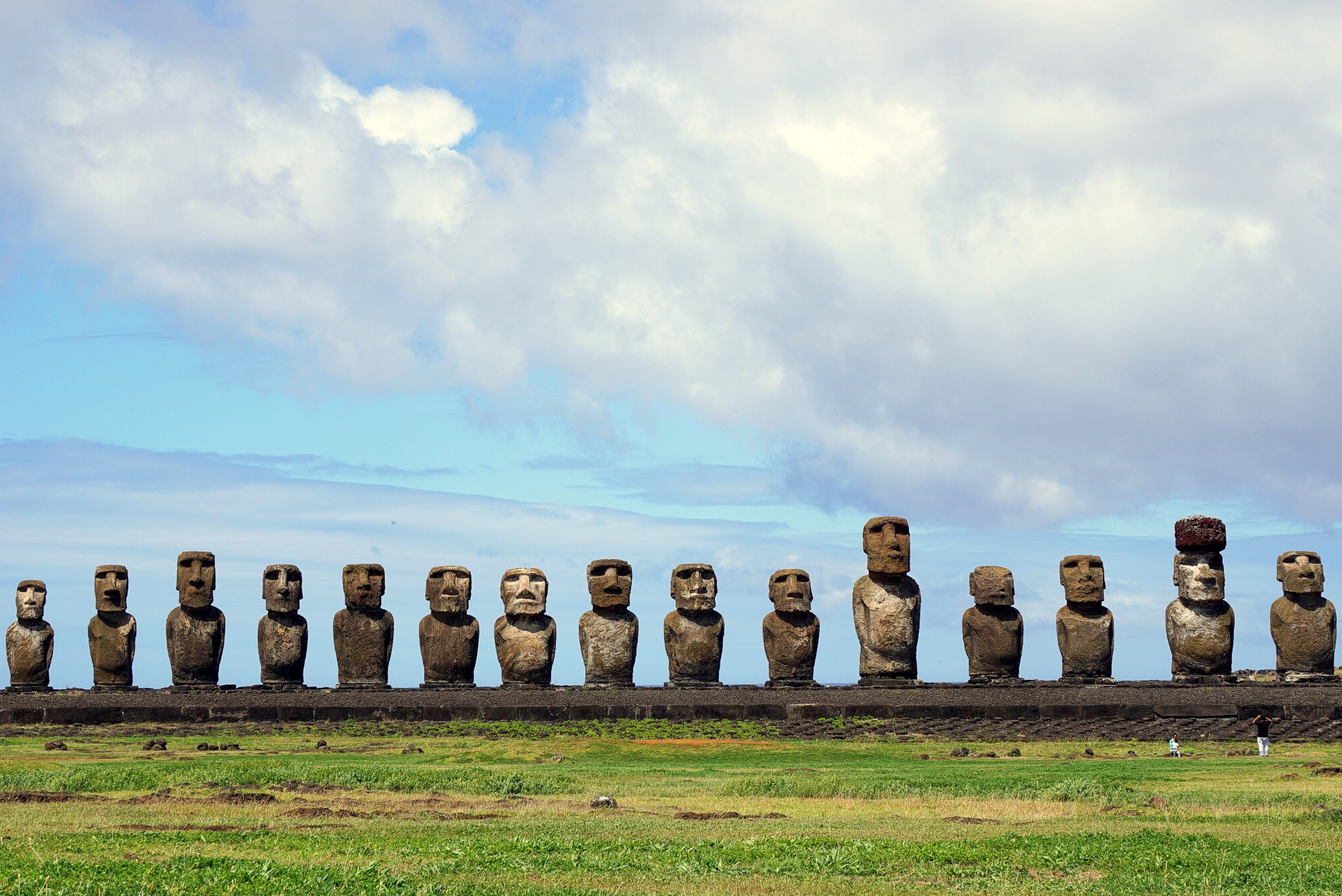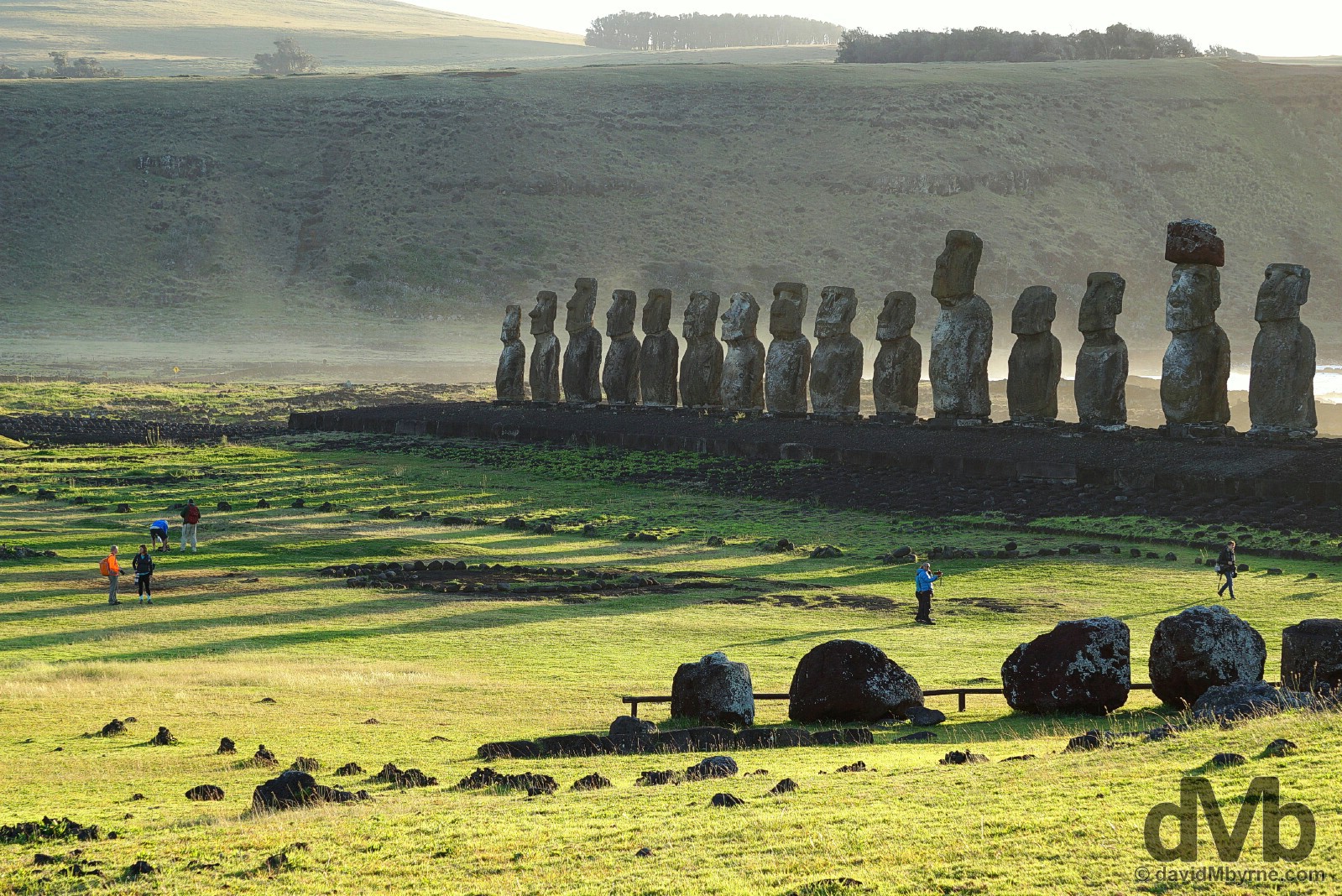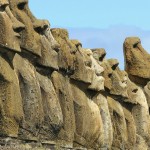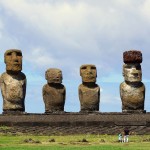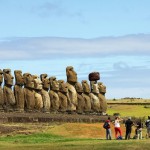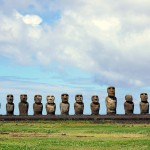Easter Island
An Exploration of Enchanting & Enigmatic Easter Island
Ahu Tongariki, Easter Island, Chile. October 1, 2015
Easter Island / Rapa Nui
A tiny spec of land in the middle of the vast Pacific Ocean some 3,700 kilometres off the coast of continental Chile on the South American mainland, Rapa Nui, the indigenous name for Easter Island, is one of the most isolated islands in the world (& the most isolated inhabited island on earth). Even so, some 800-1200 years ago a double-hulled canoe filled with seafarers from a distant culture landed upon its shores. Over the centuries that followed a remarkable society of Polynesian origin developed in isolation on the island establishing a powerful, imaginative and original tradition of monumental sculpture and architecture free from any external influence. They began carving and erecting giant statues out of volcanic rock. These monuments, known as moai, are some of the most incredible ancient relics ever discovered & form part of an unrivalled cultural landscape that continues to fascinate to this day.
– UNESCO commenting on Rapa Nui National Park, comprising some of 70 km² of the 164 km² island and which UNESCO granted granted World Heritage status in 1995.
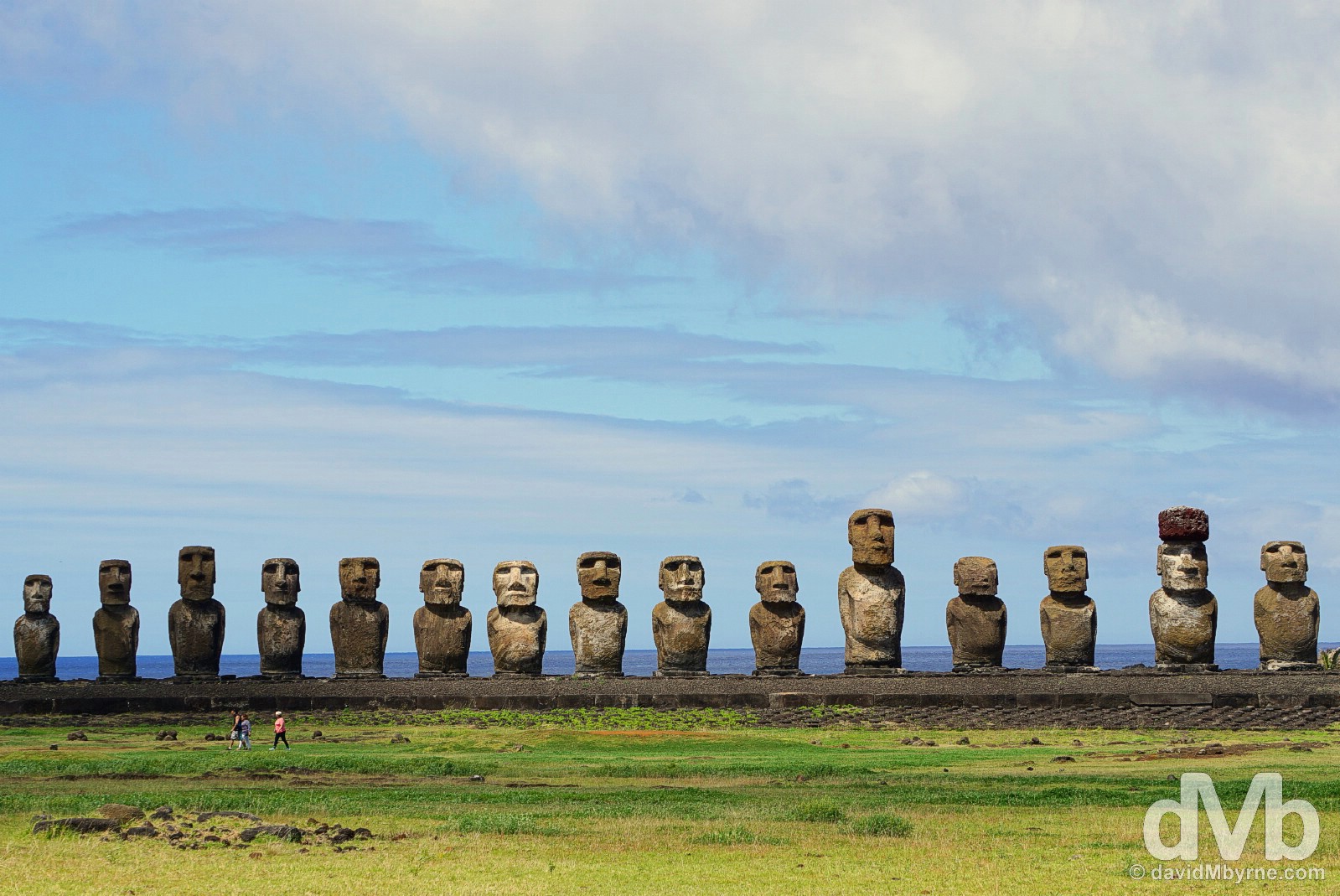
Captured on my fifth day on the island, the lineup of the 15 iconic moai of Ahu Tongariki, Easter Island’s most spectacular sight.
I spent a week on enchanting Easter Island being awed every day by its history, its enigmas, its uniqueness, and its sheer isolation. What follows is a day-by-day, picture & insight-heavy recap of my visit.
DAY 1 || Arrival, Hanga Roa, Tahai, & History (Discovery & the Moai)
DAY 2 || Orongo Ceremonial Centre & History (Turmoil & Tangata Manu/The Birdman Ritual)
DAY 3 || Ahu Tongariki & The Moai – Rise & Fall
DAY 4 || Museo Antropologico P. Sebastian Englert
DAY 5 || Easter Island Preservation, Anakena, Ahu Te Pito Kura, Puna Pau, Rano Raraku (The Moai Quarry), & The Moai In Numbers
DAY 6 || The Easter Island/Rapa Nui Stamp, Ana Kai Tangata (Cave Petroglyphs), & Ahu Tautira
DAY 7 || Ahu Tongariki Sunrise & Departure
Easter Island/Rapa Nui Highlights Location Map
Day One
Date || September 27, 2015
Location || Hanga Roa, Easter Island, Chile ( )
)
Every time I stopped to remind myself today that I was on Easter Island brought a little smile to my face. It’s beyond super cool to be here on what is one of the remotest inhabited places on planet earth, a 23-kilometre-long, 164 km² triangular island out in the middle of the Pacific Ocean some 3,700 kilometres off the South American mainland & some 2,300 kilometres from the next inhabited island. Yes, it’s way beyond super cool.
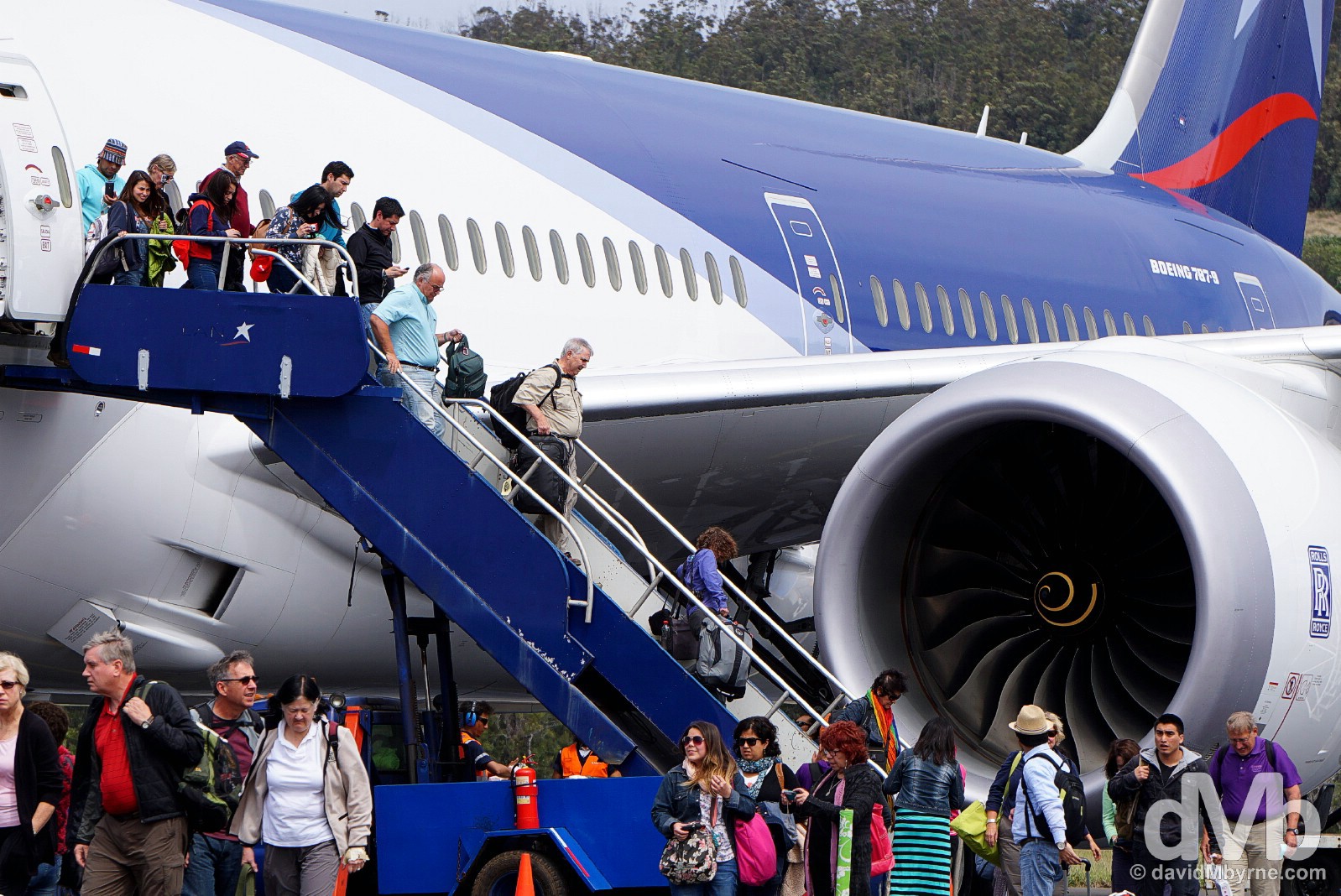
Arrival at Mataveri International Airport on Easter Island, Chile. September 27, 2015 || This little island is still isolated but it’s not as removed these days as it has been in the past thanks to at least 1 daily 5-hour flight from Santiago, Chile, 3,700 kilometres away on the South American mainland. Chilean airline LAN have a monopoly on the route meaning fares are high and delays common, just like the 3 hour delay I experienced today (computer issues with the Boeing 787 Dreamliner was the reason given when it eventually came). Easter Island’s Mataveri International Airport, the remotest airport on earth, is very small, its facilities limited. That said, its 3,300-metre-long runway can still accommodate large aircraft like the Boeing 787 Dreamliner. That’s because the airport’s runway was upgraded and lengthened in 1987 to accommodate wide-bodied aircraft, the upgrade paid for by NASA in return for allowing the island to be designated as an abort site for the U.S. Space Shuttle.
Hanga Roa & Tahai
It was a long day today. Woe is me I know but even a 4.45 a.m. alarm call, a flight delay & a 5-hour flight didn’t in any way dampen my mood. A late afternoon arrival on the island meant I didn’t venture too far from my comfortable base for the 6 nights I’ll spend here, Residencial Vaianny in the village of Hanga Roa, the island’s only settlement & home to its 7000 population. I’ll be breaking out over various parts of the island beginning tomorrow but this evening I ventured 10 minutes outside of town to Tahai, Easter Island’s de facto sunset location & the nearest gathering of the famous moai statues.
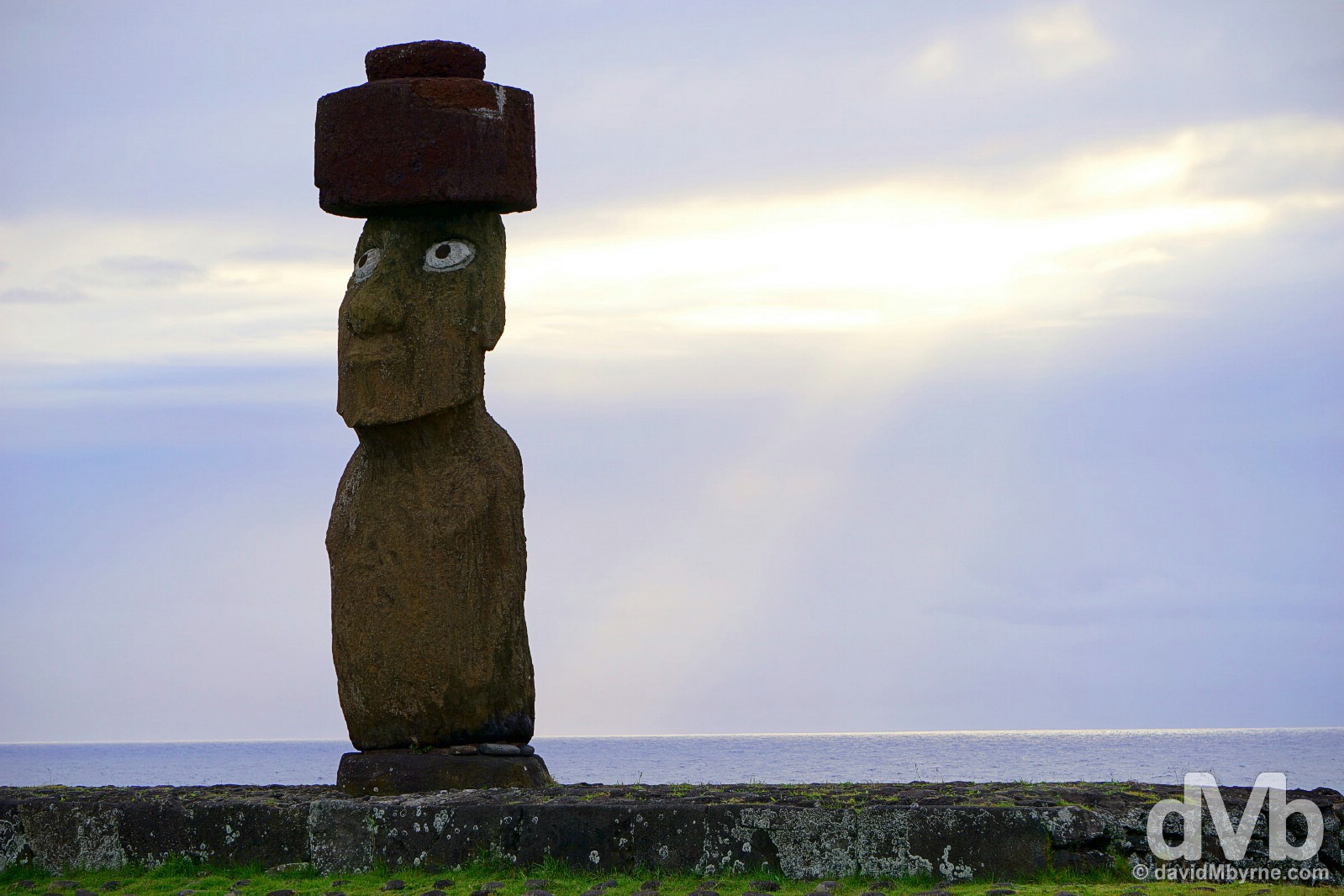
My first sighting of an iconic Easter Island moai, the well-preserved, white-eyed, red topknot-wearing moai of Ahu Ko Te Riku at the ceremonial centre of Tahai on the outskirts of Hanga Roa, Easter Island. September 27, 2015 || Conditions upon arrival today were glorious; it was sunny & warm. However, the clouds rolled in as the sun was setting, the sun’s rays piercing breaks in the clouds; with 6 nights here, I have time on my side to allow me capture a few good sunset pictures. This image was captured prior to sunset which is late out here – it was approaching 8 p.m. when I took this picture (Easter Island is GMT -6 hrs). I stood here for some time looking beyond the iconic moai and out over the vastness of the calm Pacific as the last light of my first day on the island slowly died. While here I might just have reminded myself how I’d been looking at pictures of this place for aeons. And I also might have, once again, commented silently to myself how cool it was to be here now making my own pictures. And yes, I might also have smiled a few times too. I’ve a few miles on the clock but I still feel oh-so privileged to be here & will hopefully never take moments like I had this evening for granted.
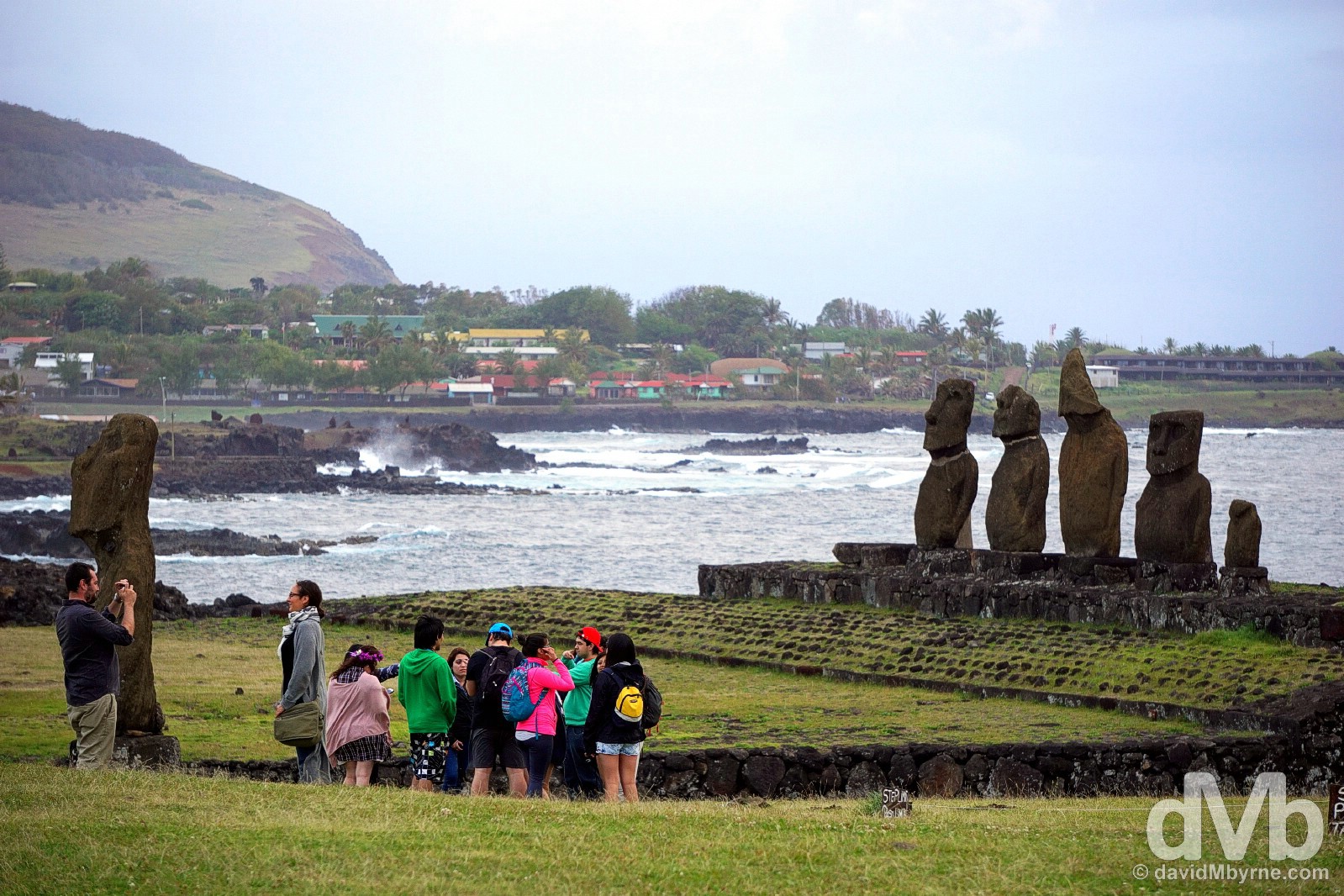
Approaching the end of Day 1 at the ceremonial centre of Tahai on the outskirts of Hanga Roa with the slopes of the island’s Rano Kau volcano (see Day 2) in the distance. Easter Island, Chile. September 27, 2015. || While the vast majority of Easter Island’s ceremonial centres house just one, the ceremonial centre of Tahai outside Hanga Roa contains a total of three ahu, rectangular-shaped elevated platforms upon which the moai statues were erected and which were the spiritual centre of a larger ceremonial space, a sacred space outlined by stone walls or stone pavements (or both). This image shows the (mostly badly eroded) moai of Tahai’s two other ahu – the lone moai of Ahu Tahai itself (left) & the 5 moai of Ahu Vai Uri (right). Like all ceremonial centres dotted around Rapa Nui, the Tahai landscape was extensively modified to create the site and to accommodate it & the many other archaeological structures typical of such settlements, in what was probably some of the very earliest land reclamation projects ever undertaken by humans.
It’s only Day 1 on Easter Island. There’s more to come from enchanting Rapa Nui. Lots more.
HISTORY I - DISCOVERY & THE MOAI
Day Two
Date || September 28, 2015
Location || Hanga Roa, Easter Island, Chile ( )
)
I spent the day today being awed some more by Easter Island. It was a pleasant day in these parts. My first port of call was the ceremonial village of Orongo. Perched high on the rim of the crater of the extinct Rano Kau volcano at the extreme southwest of the island, it was a stiff 90-minute (mostly) uphill walk from my base in Hanga Roa. Orongo was the centre of the island’s annual birdman ceremony. And while so much uncertainty remains about aspects of the island’s past, the cult of the birdman is well understood as it was practised right up until 1878.
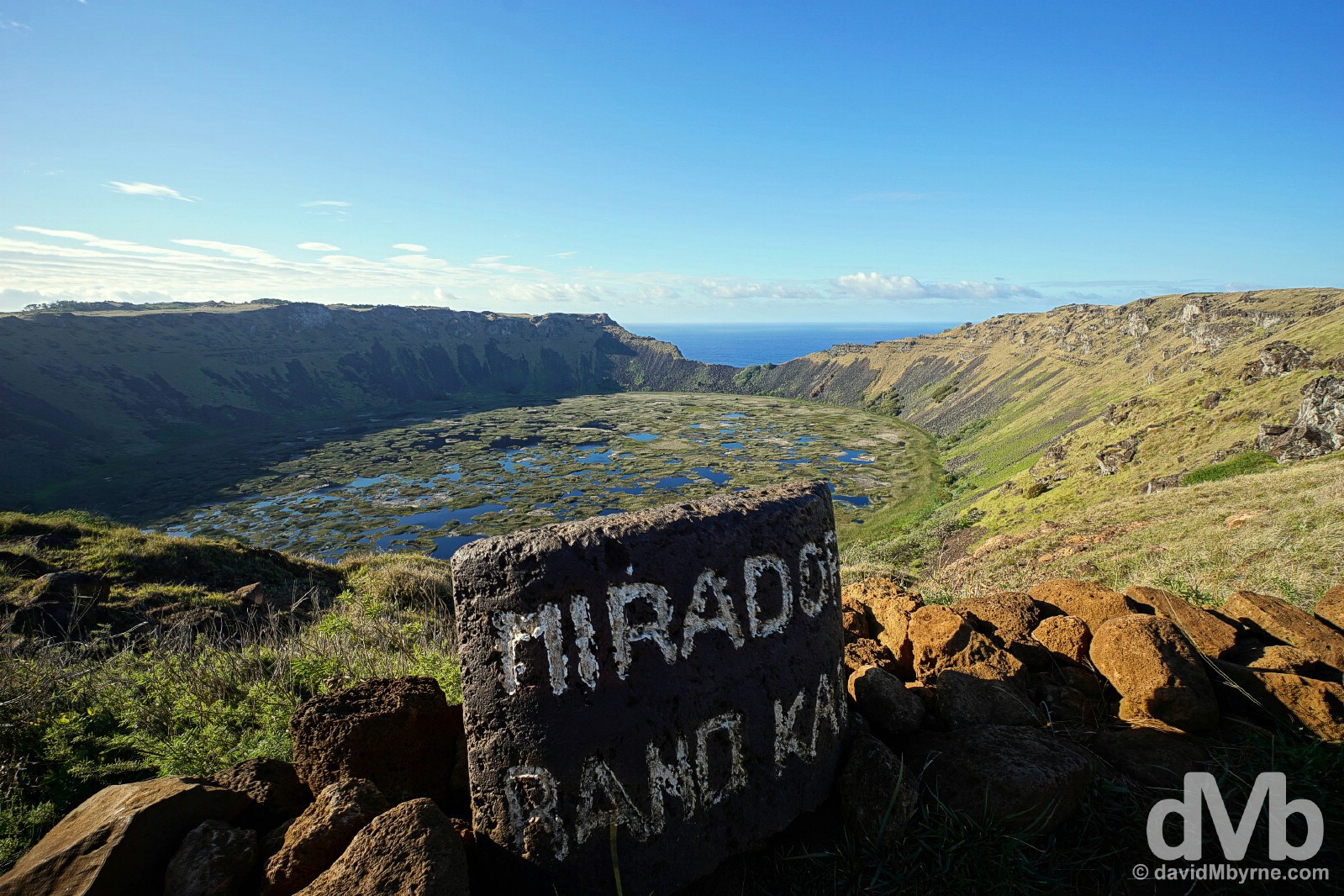
Looking over the crater from the rim of the extinct Rano Kau volcano, Easter Island, Chile. September 28, 2015 || Triangular Easter Island was formed by the eruption of 3 volcanoes, the first of which was some 3 million years ago. This is the crater of the second of the 3 volcanoes to erupt, Rano Kau, which blew its top some 2.5 million years ago. Measuring 1.6 kilometres in diameter, it is the largest crater on the island. Its 11 metre-deep, fresh water, reed-choked lagoon is a highlight of the island but for me the views of the brilliantly blue Pacific Ocean stretching into the distance as seen through a missing chunk of the crater wall stole the show.
HISTORY II - TURMOIL & TANGATA MANU/THE BIRDMAN RITUAL
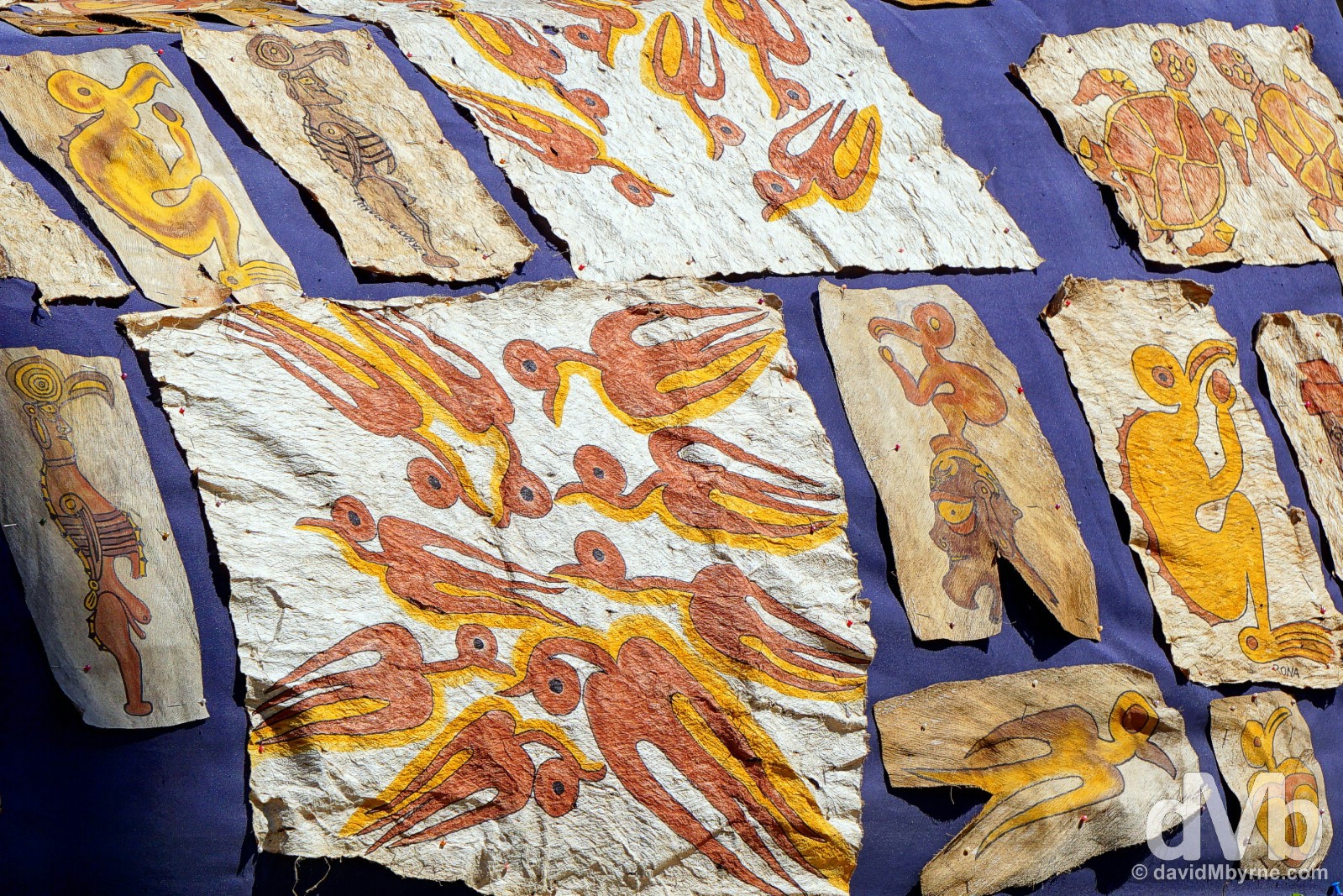
Tangata Manu/birdman symbolisation for sale at Anakena, Easter Island, Chile. || The figures depicted here were the critical element in the annual competition associated with the birdman cult, curled-up human figure holding an egg & with birds’ heads and long caved beaks.
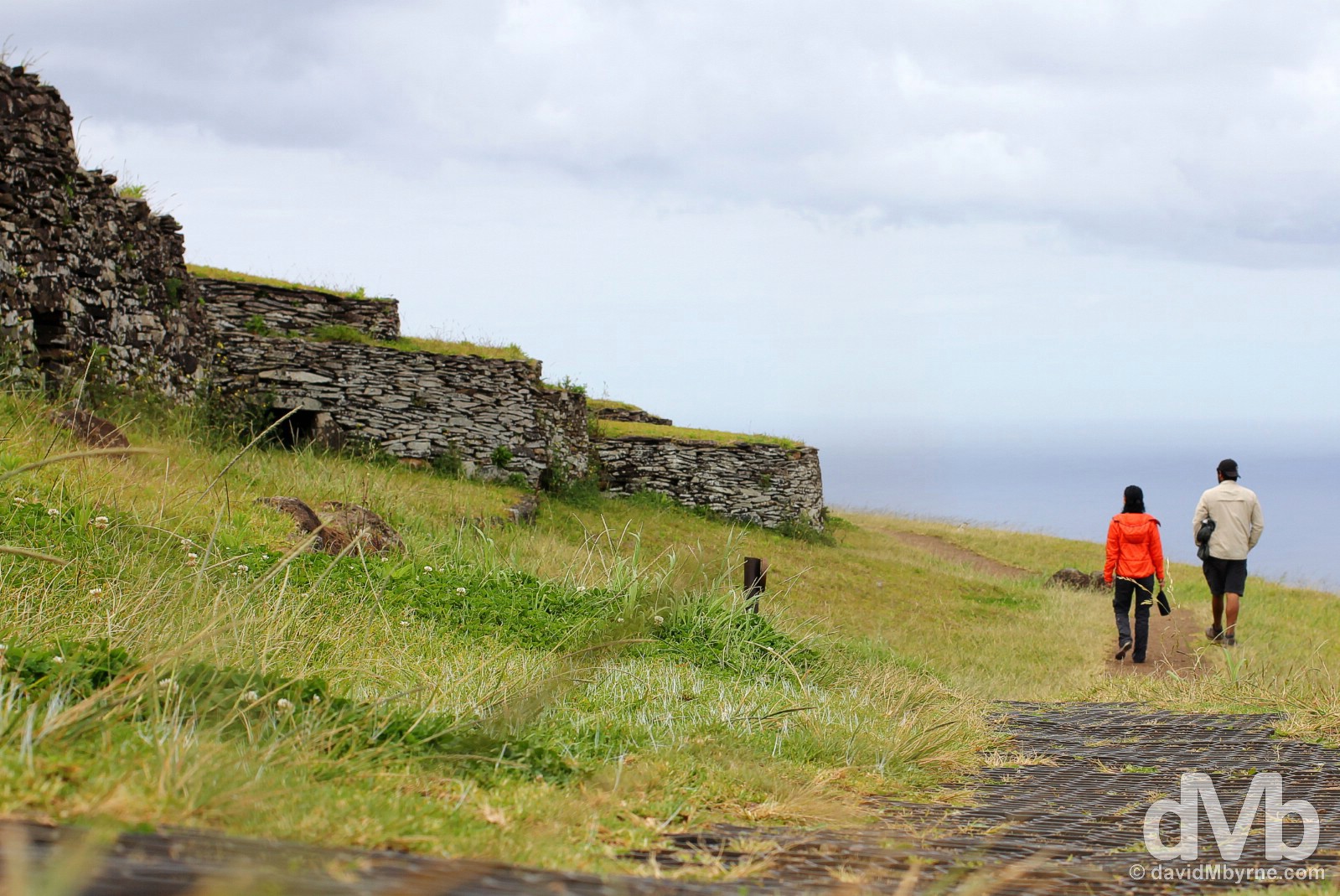
Orongo, Easter Island, Chile. September 28, 2015 || The most important ceremonies of the birdman cult took place here at the ceremonial village of Orongo on the ridge of the Rano Kau volcano & overlooking the rocky islet of Motu Nui offshore. The ceremony, or competition, to elect a new birdman could take weeks as the Hopu waited & searched for the first egg of the year. While Rapa Nui’s inhabitants waited, various ceremonial activities took place here in Orongo, a ceremonial village of over 50 low-lying, oval-shaped stone slab huts, the partially restored remains of some of which are seen here facing the sea. When first explored & excavated, these huts contained various petroglyphs & even small moai with carvings of curled-up human figures with birds’ heads and long caved beaks & holding an egg, birdman symbolisation. There were also carvings of Makemake. The most important of all Rapa Nui gods & central to the birdman ritual, he was considered the creator god of humanity. His presence was exclusive to Rapa Nui & some 500 petroglyphs depicting the deity have been found in various locations around the island, although mostly here at Orongo.
Having returned from the rim of Rano Kau to Hanga Roa, it was time for sunset back at the Tahai ceremonial centre. And what a beautiful end to the day it was.
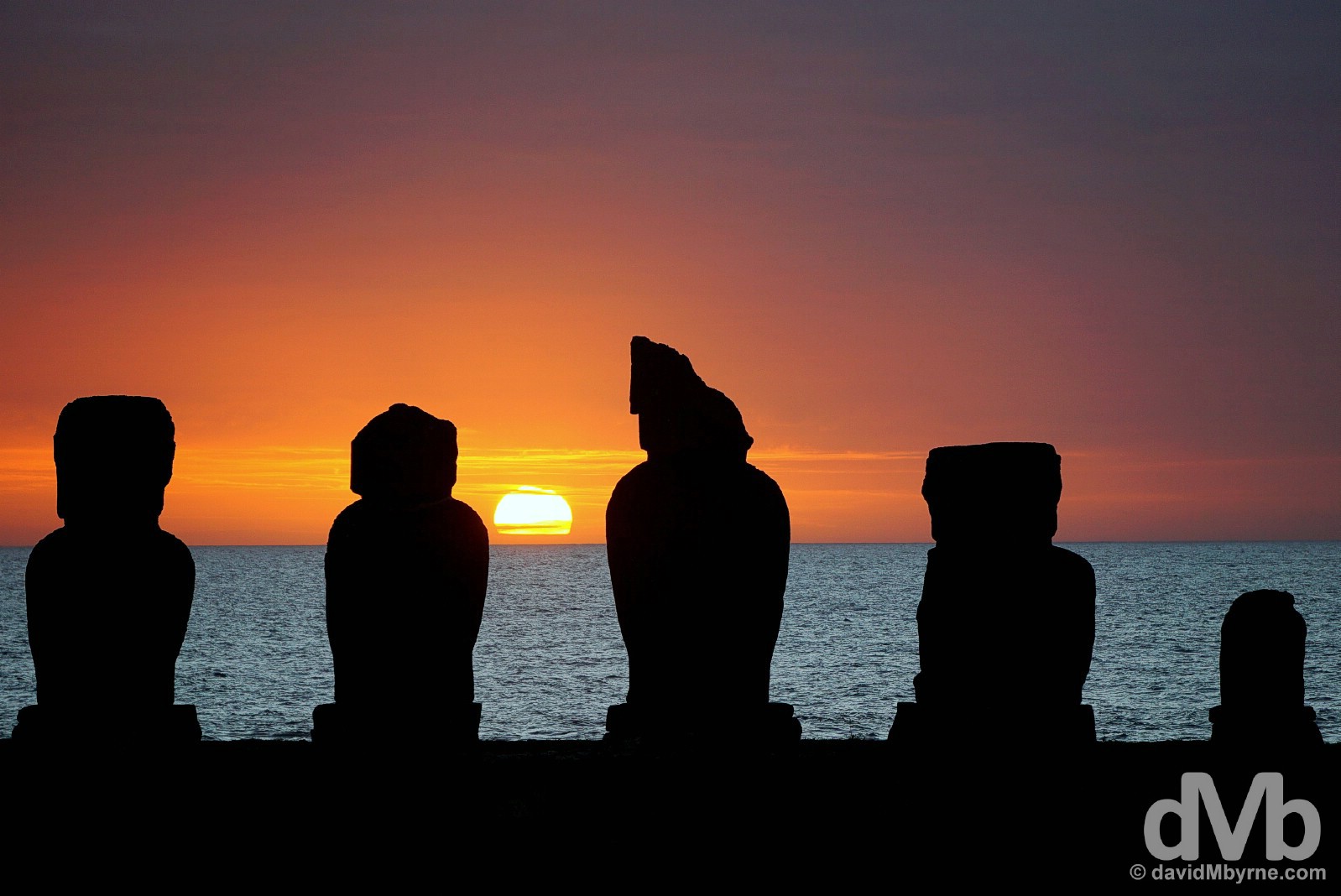
Sunset at Ahu Vai Uri, Tahai, Easter Island, Chile. September 28, 2015 || The silhouetted outline of the remaining 5 (of 6 originally) broad, squat & badly eroded moai of Tahai’s Ahu Vai Uri, one of which is nothing more than a stump these days.
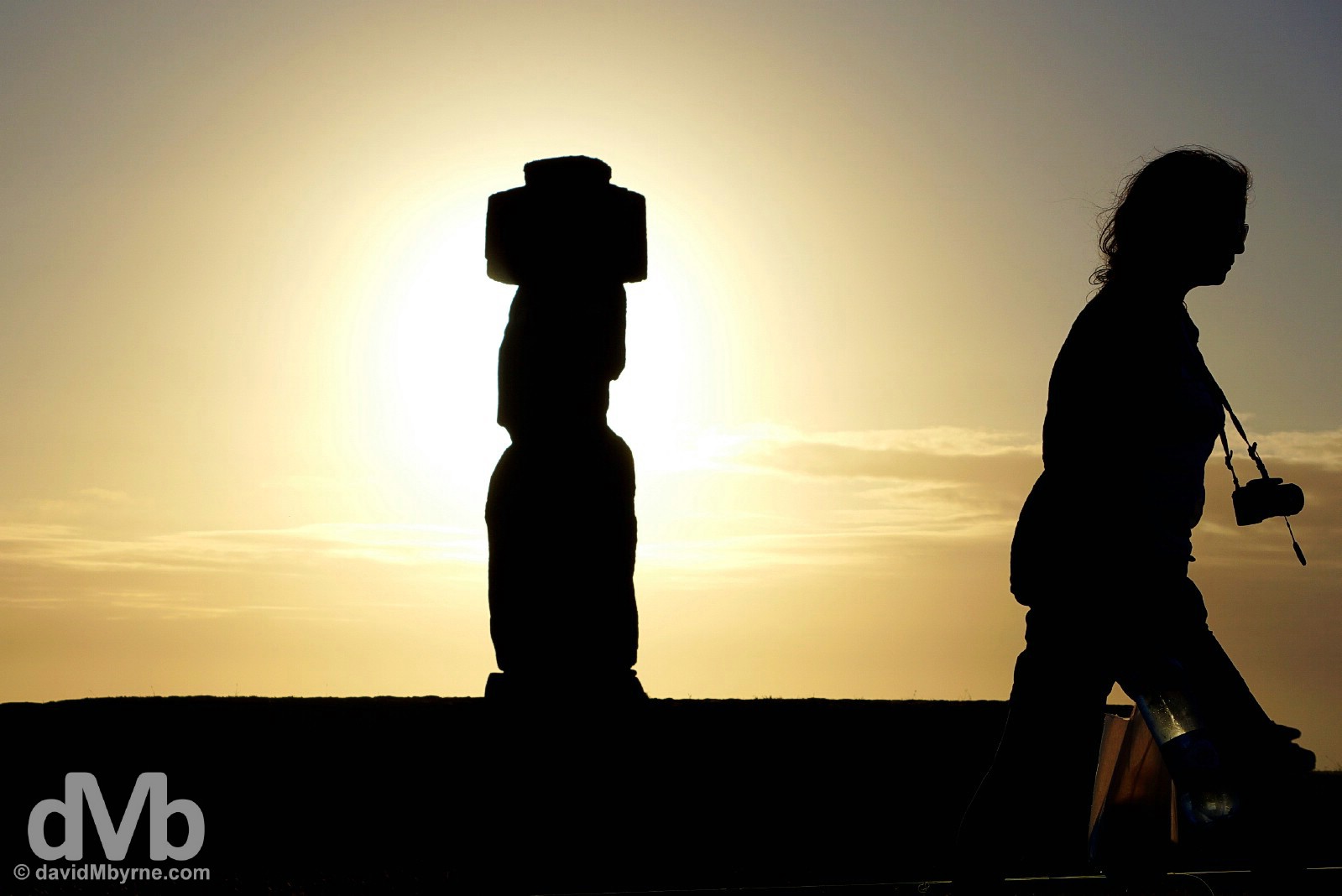
Sunset silhouettes at Ahu Ko Te Riku, Tahai, Easter Island, Chile. September 28, 2015.
Two days down. I still have much more time remaining on the island than has already passed but I know already I’m going to miss this place.
Day Three
Date || September 29, 2015
Location || Hanga Roa, Easter Island, Chile ( )
)
Easter Island only measures some 164 km². It’s almost small enough to explore by bicycle, assuming you have the time and energy. I have both so today saw me breaking out from Hanga Roa on my luminous green mountain bike to skirt the island’s 16 kilometre-long southern coast. Dotted with ahu, platforms for the once proudly erect moai statues that now mostly lay fallen in the vicinity, the coastal road ends at the island’s most spectacular sight, the awe-inspiring Ahu Tongariki, 20 kilometres in total from Hang Roa and on the opposite side of the island.
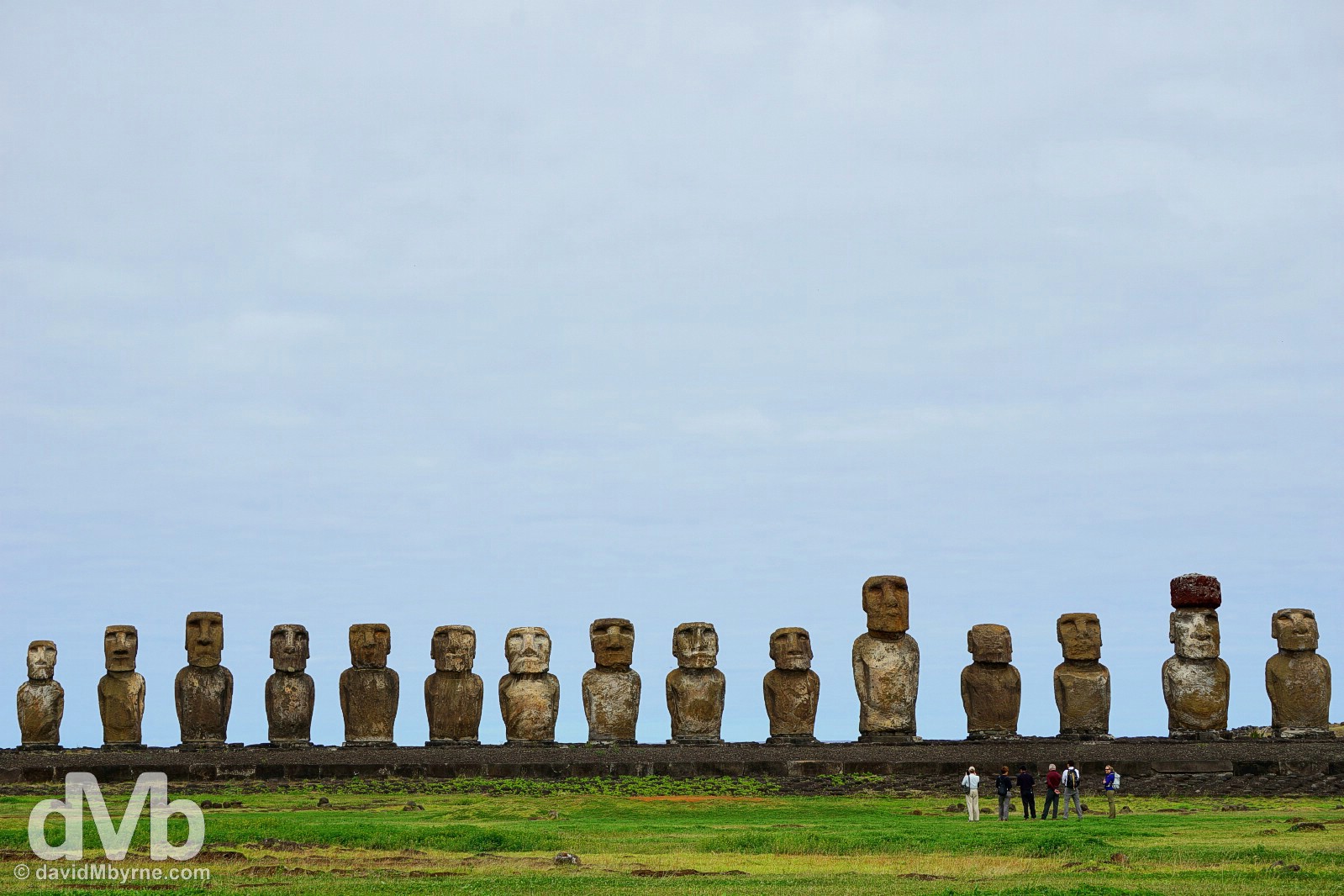
The moai of Ahu Tongariki on Easter Island, Chile. September 29, 2015 || A moment I will scarcely ever forget, my first time in the presence of the moai of Ahu Tongariki, one of the world’s most sensational sights & the largest ahu to be found on Easter Island. Measuring 200 metres long, Ahu Tongariki is the largest gathering of moai on Easter Island. Home to no less than 15 moai, including an 86-tonne moai, the heaviest ever erected on an ahu, it was completely destroyed by a tsunami in 1960, one so powerful it carried some of the smaller 30-tonne moai upwards of 90 metres inland. The ahu lay in ruins for over three decades until being returned to its present state thanks to a joint Japanese-Chilean restoration project that was competed in 1995.
Moai, the symbol of Easter Island & exclusive to it, were created, it is widely believed, to represent the important ancestors of each clan. Installed on ahu and facing inland to protect the clan’s territory, they also visually represented the power of the clan and as such over time they began to be carved larger and larger. The increasing need to demonstrate power & prestige through the moai eventually led to clan disputes for dwindling resources such as wood & food. This eventually led to societal upheaval & the toppling of the great statues, most of which remain toppled to this day.
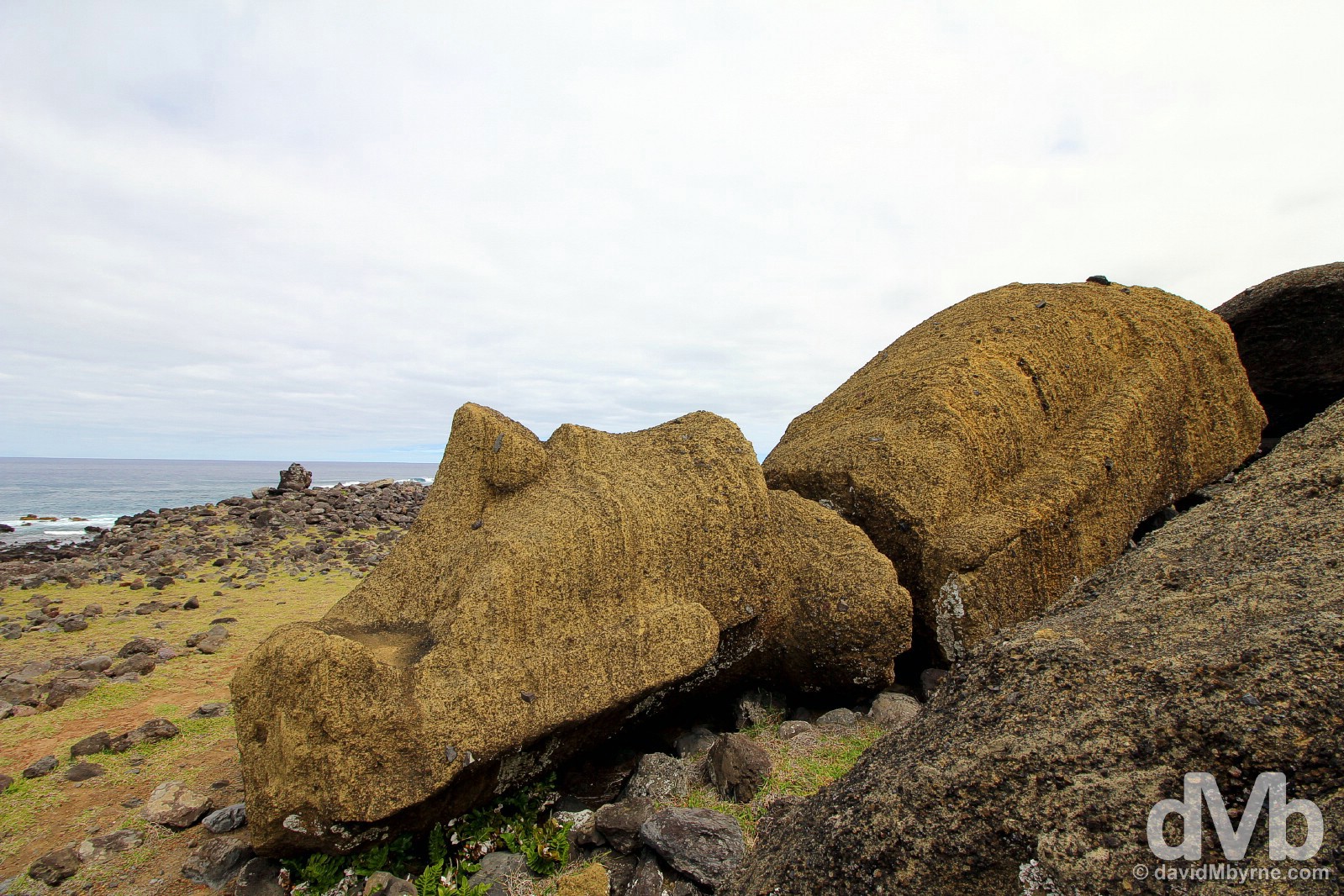
A fallen giant. A toppled moai at One Makihi, Easter Island, Chile. September 29, 2015 || All of the 288 moai erected on ahu that dot the coastline of Easter Island were toppled as a result of the tribal warfare that marked the end of the island’s statue worship Ahu Moai period. Some of the moai have been restored and stand proud once again lording over their ancesterial lands. But very few, the 15 moai of Ahu Tongariki the most well-known and spectacular example. The majority, just like this giant at the site One Makihi not far from Ahu Tongariki on the island’s southern coast, lay where they fell all those years ago. For centuries the iconic moai silently guarded and protected the Rapa Nui, presiding over the daily life of its people. Sadly today they seem resigned to the passage of time.
There’s more of the island to explore beyond its southern coast which, admittedly, holds the bulk of Ester Island’s must-sees. I’ll tour the island again in a few days’ time when the pending hurt, mostly saddle sore & sunburn, has subsided (and I think I’ll hire motorised transport next time). I might just have to take it easy again until then.
Day Four
Date || September 30, 2015
Location || Hanga Roa, Easter Island, Chile ( )
)
It rained today on Easter Island. A few times. Just light showers. Nothing major. Apart from the drizzle it was a glorious day on this little Pacific high volcanic island. High volcanic islands are one of 4 types of Polynesian islands, islands created as a result of strong eruptions through fractures, or hot spots, in the ocean floor (the islands of Hawaii were created the same way, as I blogged about some time ago on my last visit to that particular corner of Polynesia). I know that little titbit of information because today I brushed up on my geology in the island’s excellent Museo Antropologico P. Sebastian Englert, somewhere I spent a good chunk of the day being further schooled on all things Easter Island.
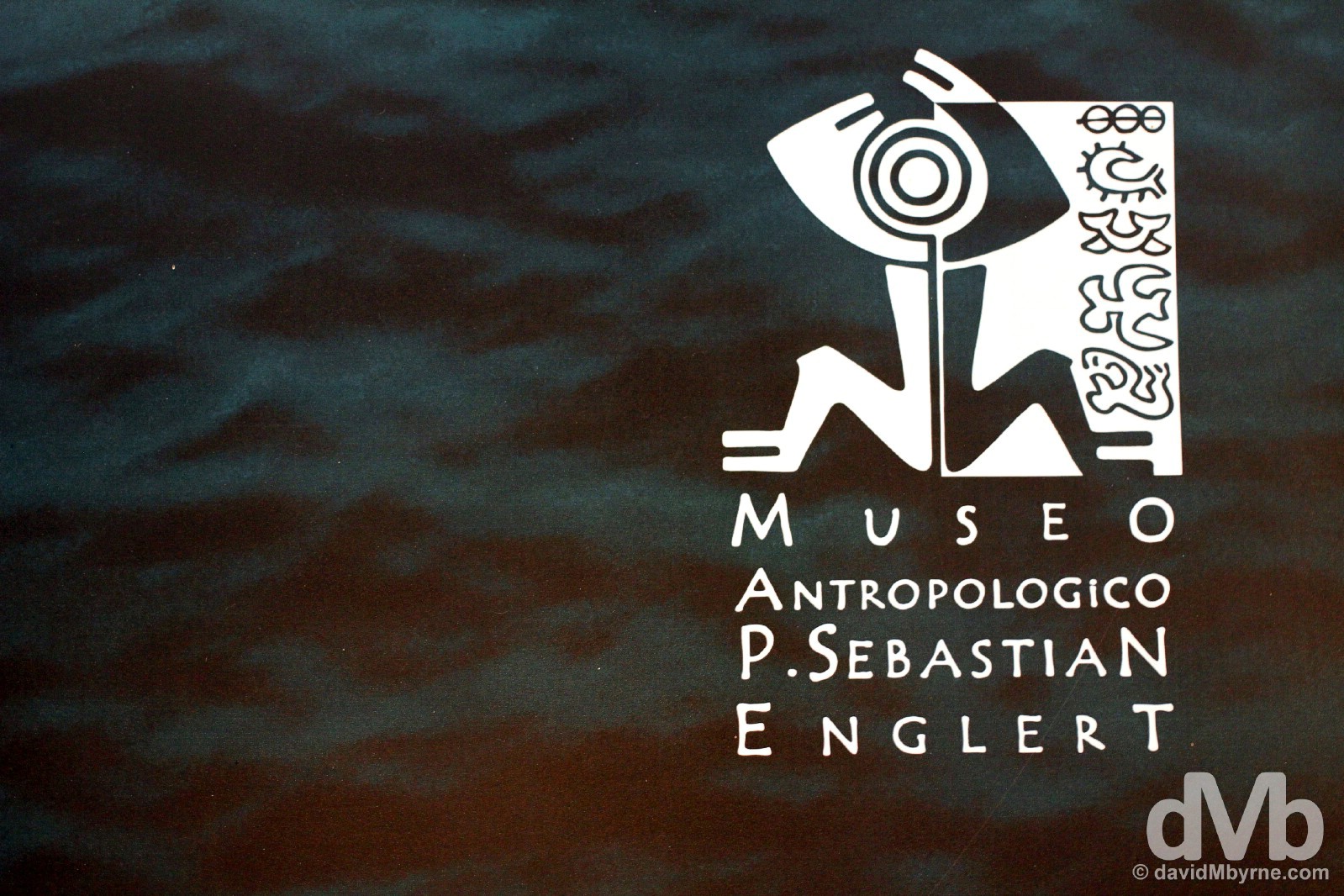
Museo Antropologico P. Sebastian Englert, Hanga Roa, Easter Island, Chile. September 30, 2015 || Easter Island’s Museo Antropologico P. Sebastian Englert was/is awesome. Named after Father Sebastian, a German capuchin missionary who studied the way of life and language of Rapa Nui society, the museum is short on flashy interactive displays, fancy lighting, & overbearing guards (& it’s minus an entrance fee too). What it does is deliver good information in a simple & concise manner, covering everything from Easter Island’s formation to its early colonizers, to the rise & fall of its indigenous societal plan, & of course the full spiel on the astonishing & unique statue cult that saw the production, erection & ultimate toppling of the iconic moai, the enduring symbol of the island. ‘The island of mysteries’ is what the museum claims Easter Island to be, stating that in 300 years of contact with the western world the island has been represented as a place of unexplained mysteries. Very true – there seems to be an enigma around every corner out here – and it’s the mysteries that add to the fascination of this enchanting place.
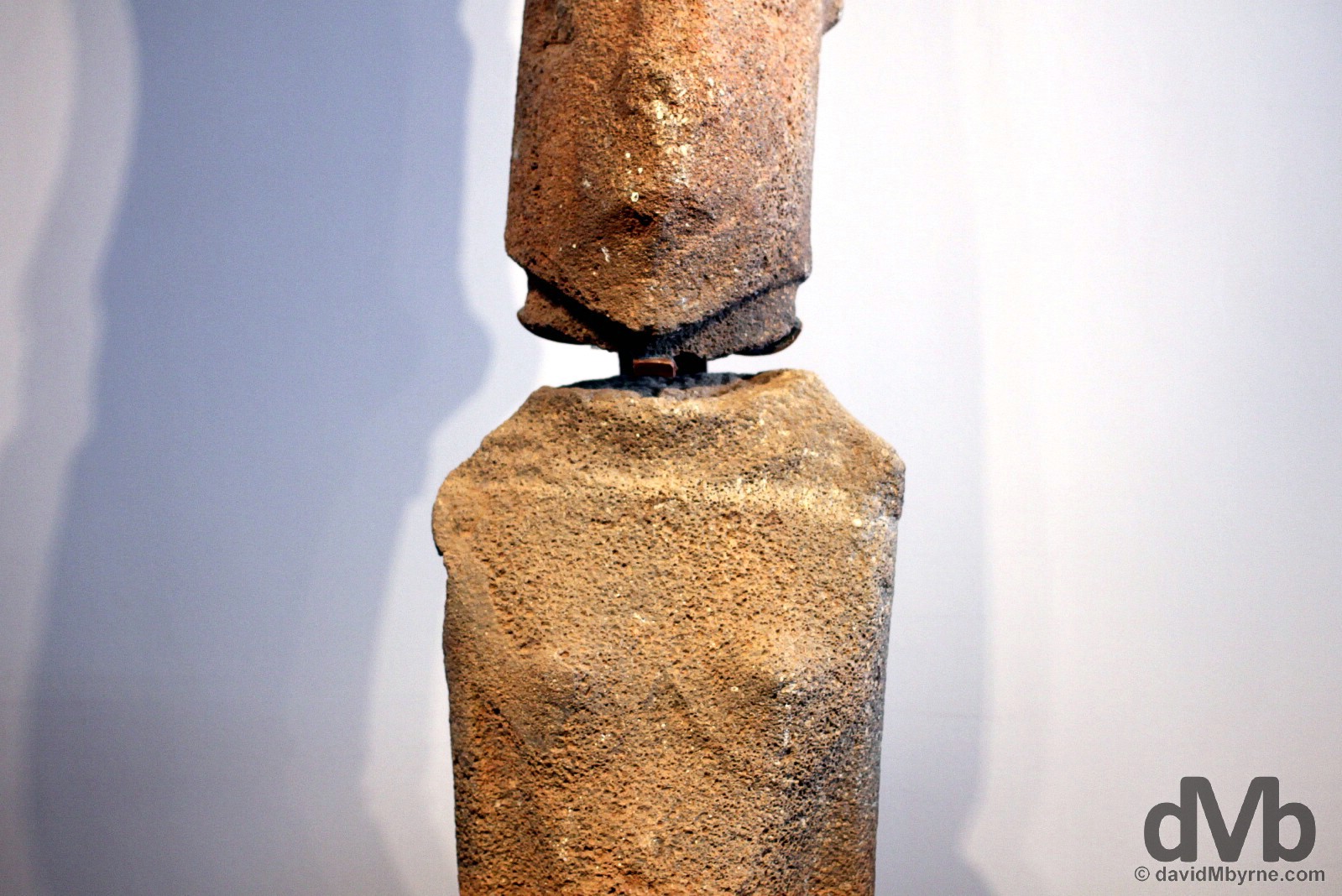
A female moai in the Museo Antropologico P. Sebastian Englert, Hanga Roa, Easter Island, Chile. September 30, 2015 ||Female moai. Well I never. I never gave a second thought to the sex of the Easter Island moai (hands up if you did). The feminists out there will be happy to know that yes, indeed there were female moai, moai with breasts, although not very big ones (the moai or the breasts) & not too many – only about 10 moai display feminine features out of a total of 887 moai registered, as per figures displayed in the museum (other unusual moai include kneeling moai and moai with buttocks). This small female was unearthed as a torso in 1956 by a Norwegian Expedition before being whisked off to Oslo. Amazingly the head was uncovered some 30 years later, in 1988. A request was put in and the torso was returned to Easter Island to be reunited with the head, both now on display here in the Museo Antropologico P. Sebastian Englert to appease the likes of me.
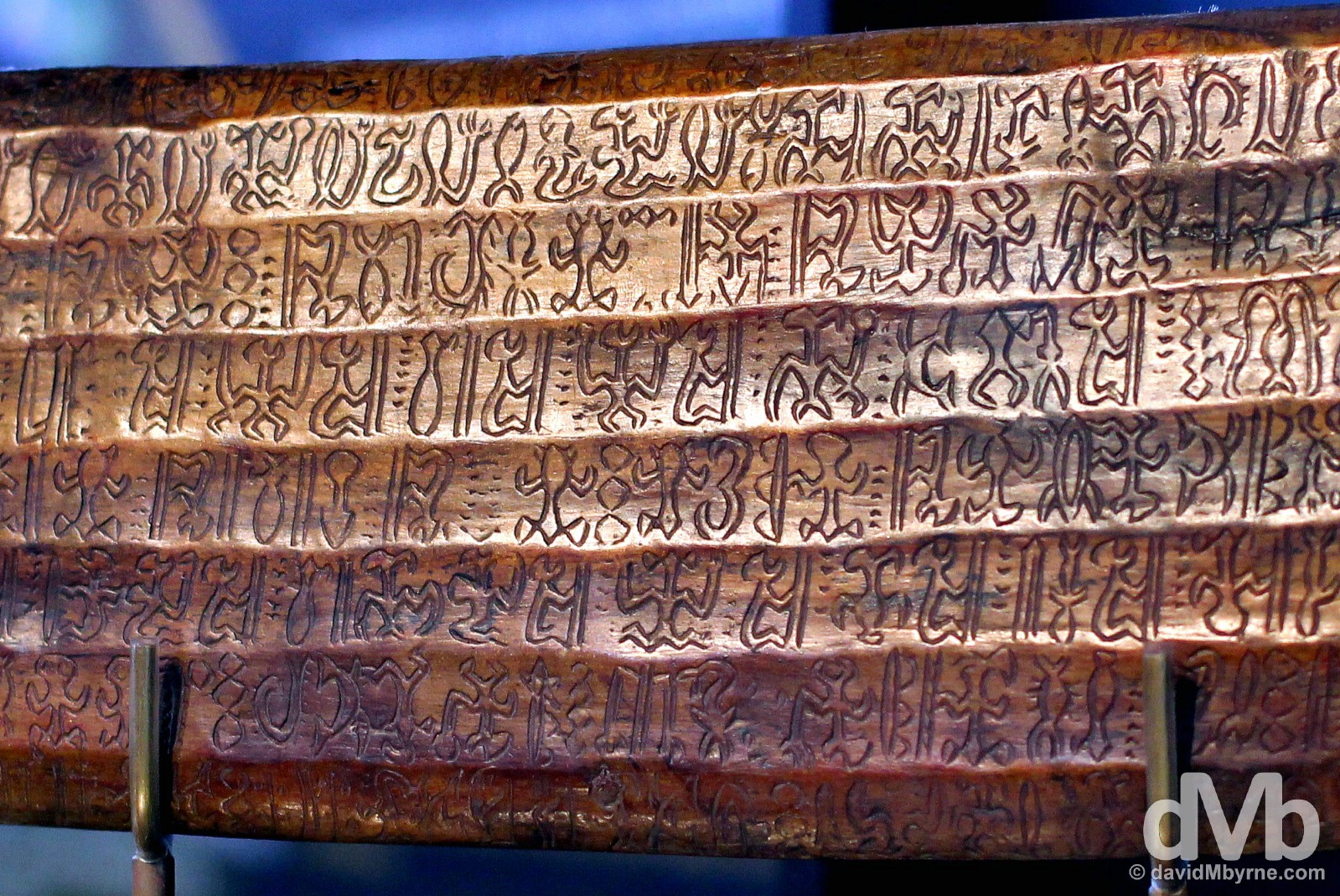
A Rongorongo tablet on display in the Museo Antropologico P. Sebastian Englert, Easter Island, Chile. September 30, 2015 || One of the most enigmatic aspects of Rapa Nui culture ever found, engraved tablets proved that there existed some kind of writing system on Easter Island. This writing system, called Rongorongo, has no precedence in Polynesia and is one of only 4 known writing systems in the world to have been developed independent of any outside influences. Only a select grouping of scholars in Rapa Nui society could decipher the symbols, experts lost in island purges by Peruvian sailors in the 1860s meaning knowledge of their true meaning was lost forever – numerous attempts at deciphering the Rongorongo symbols have been made since, none successfully. 28 original tablets or objects with symbolisim are known to exist to this day, all of which were lost to foreign invaders & plunderers & shockingly none of which are to be found on Easter Island – this is a reproduction on display in the museum.
I spent the rest of the day walking a bit of the coast outside Hanga Roa, staring at more moai, & loafing around the leafy, fragrant streets of the town. I stopped by the local church to say hi to someone who’s dearly missed (it reminded me of a typical community hall, boxy & functional) & had a few coffees in a few cafes. Oh, and I found time for a selfie.
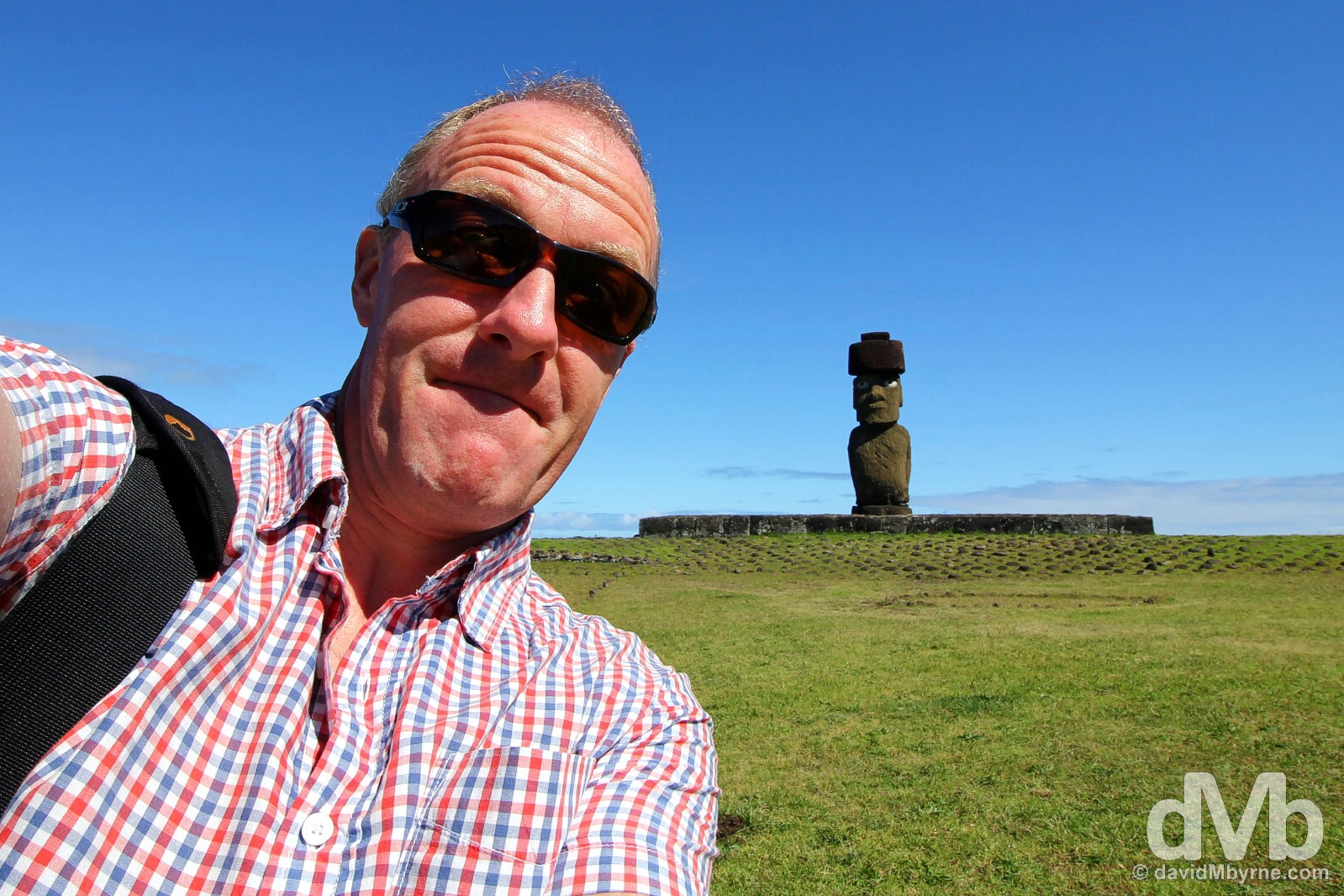
dMb selfie at Tahai, Easter Island, Chile. September 30, 2015 || I don’t do selfies – you can probably see why – and I certainly would never upload one to my blog. Not normally. But I’ll make an exception for Easter Island. Plus, it was a slow photography day.

Tahai, Easter Island, Chile. September 30, 2015.
All of today’s shenanigans brought me invariably to that time of day, sunset down at Tahai, about as ritualistic an event as you’re going to get on present-day Easter Island.
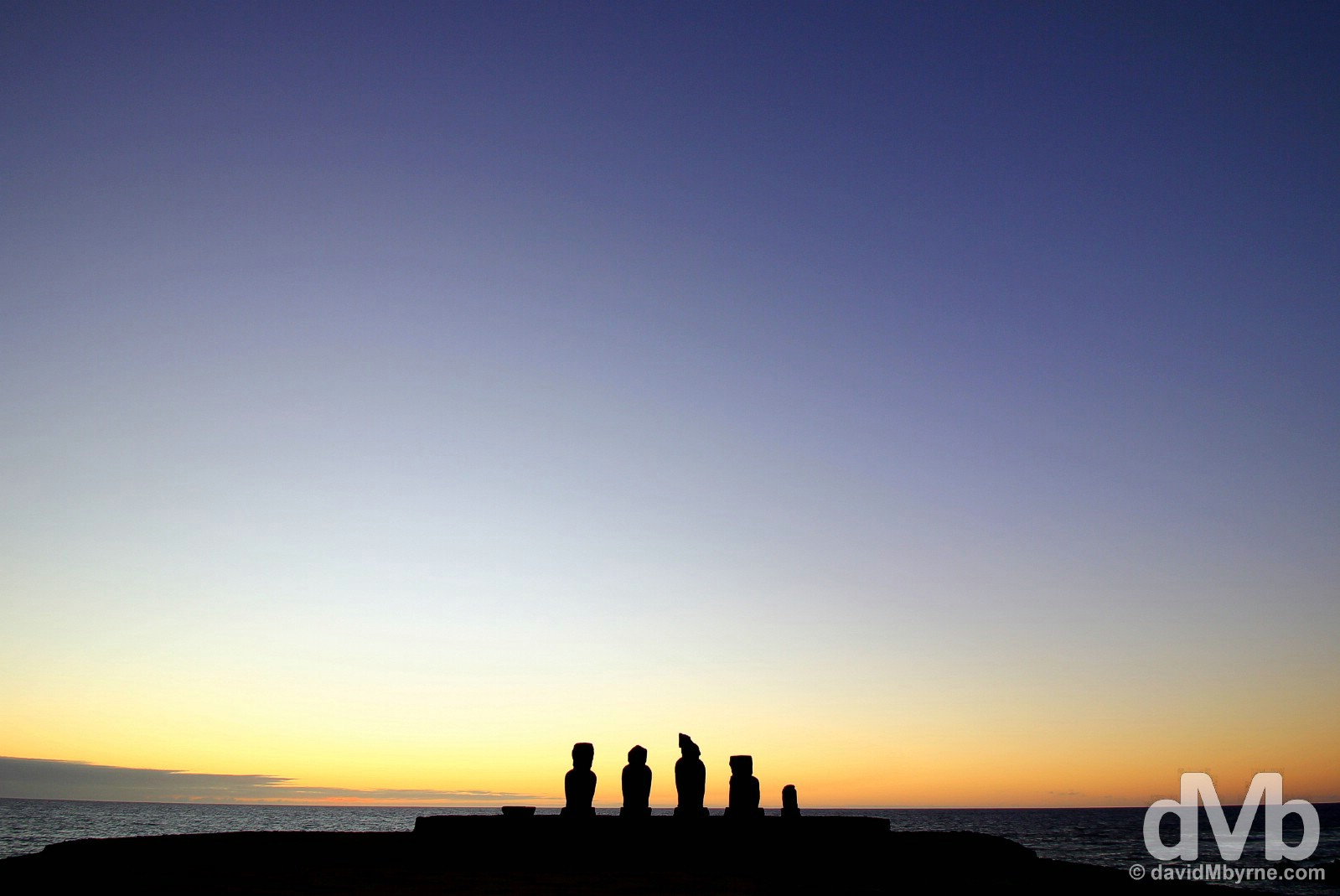
Post sunset silhouette at Tahai, Easter Island. September 30, 2015 || It was busy this evening for sunset at Tahai, busier than I’ve seen it thus far – tonight was my 4th Easter Island sunset. Very few clouds meant the day was smashing but the sunset itself a little too perfect – you need a cloud or two. The post sunset sky was much more photogenic.
I’ll be back on the road tomorrow, this time on a scooter, touring the portions of the island I’ve yet to see. Here’s hoping the good weather of today has the decency to stick around for tomorrow, day 5 on the island. Wow, day 5 already. Time really does fly when you’re having fun.
Day Five
Date || October 1, 2015
Location || Hanga Roa, Easter Island, Chile ( )
)
By now I’ve navigated all the main roads on Easter Island. There aren’t many. Any stretches of tarmac I didn’t cycle on day 3 were driven today, day 5, as I spent the day zipping around the island dodging cows and wild horses – Beep! Beep! – on my 100 cc hired Yamaha scooter.
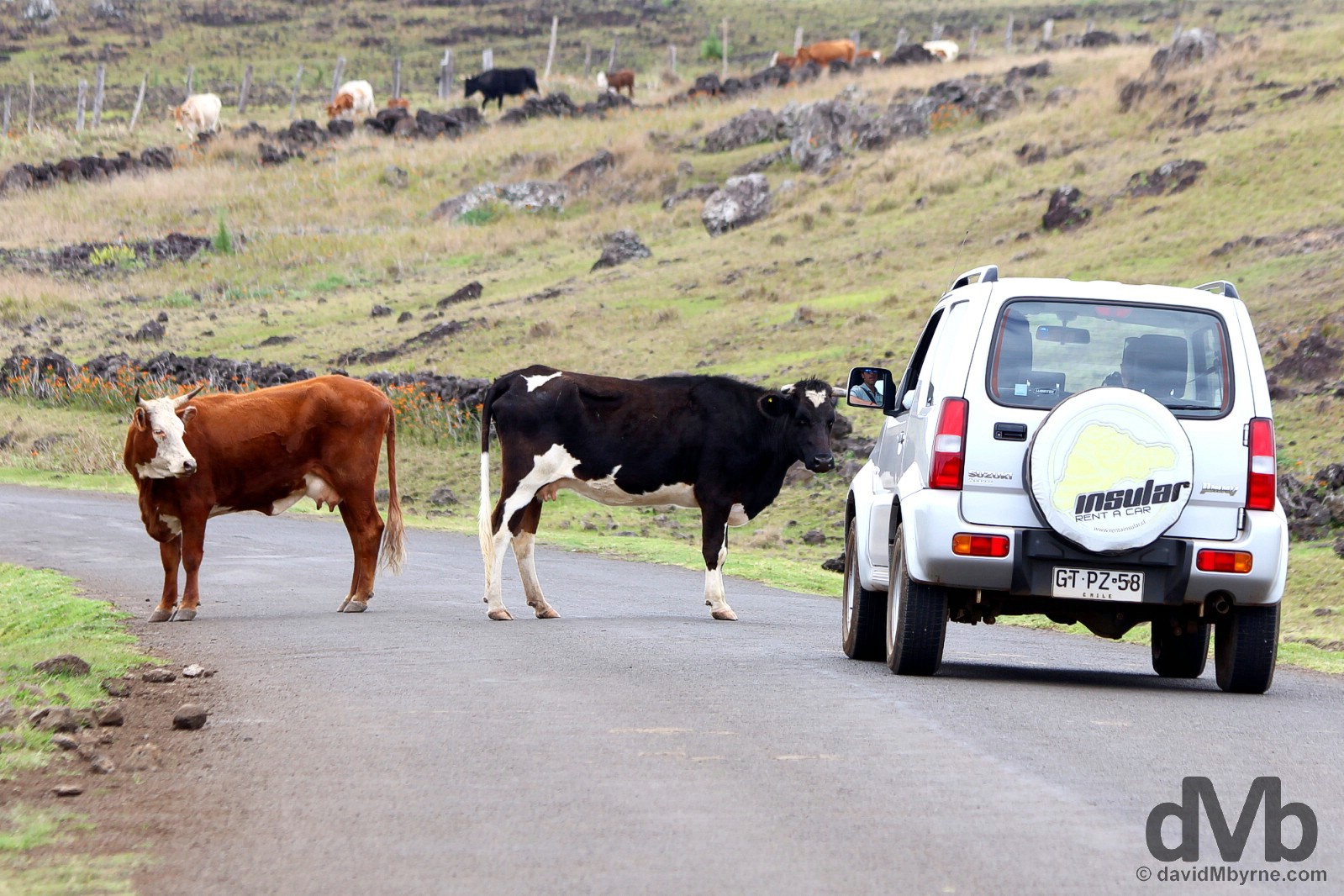
Sharing the roads of Easter Island, Chile. October 1, 2015 || I don’t have figures but I assume cows & wild horses collectively outnumber humans on Easter Island – they are everywhere, people aren’t.
Almost from the moment they were created, the unique archaeological treasures of Easter Island – the moai statues, the ahu, the petroglyphs & various other rock art – began to suffer the effects of different deterioration processes, mostly surface erosion, cracks, weathering etc. – all are outdoors and thus subjected to not only the weather but sea breezes. Livestock is also a modern-day issue as out-of-control cattle graze all over the island. Tourism, although the sole money earner for the island these days, is a growing concern too as the island becomes more accessible and thus attracts more visitors.

A preservation heads-up at Ahu Tongariki, Easter Island, Chile. September 29, 2015.
My hired Yamaha got me to the parts of the island I had yet to see and back to parts I’d already frequented. There are some places on Easter Island you need to visit more than once. Sometimes a lot more than once.
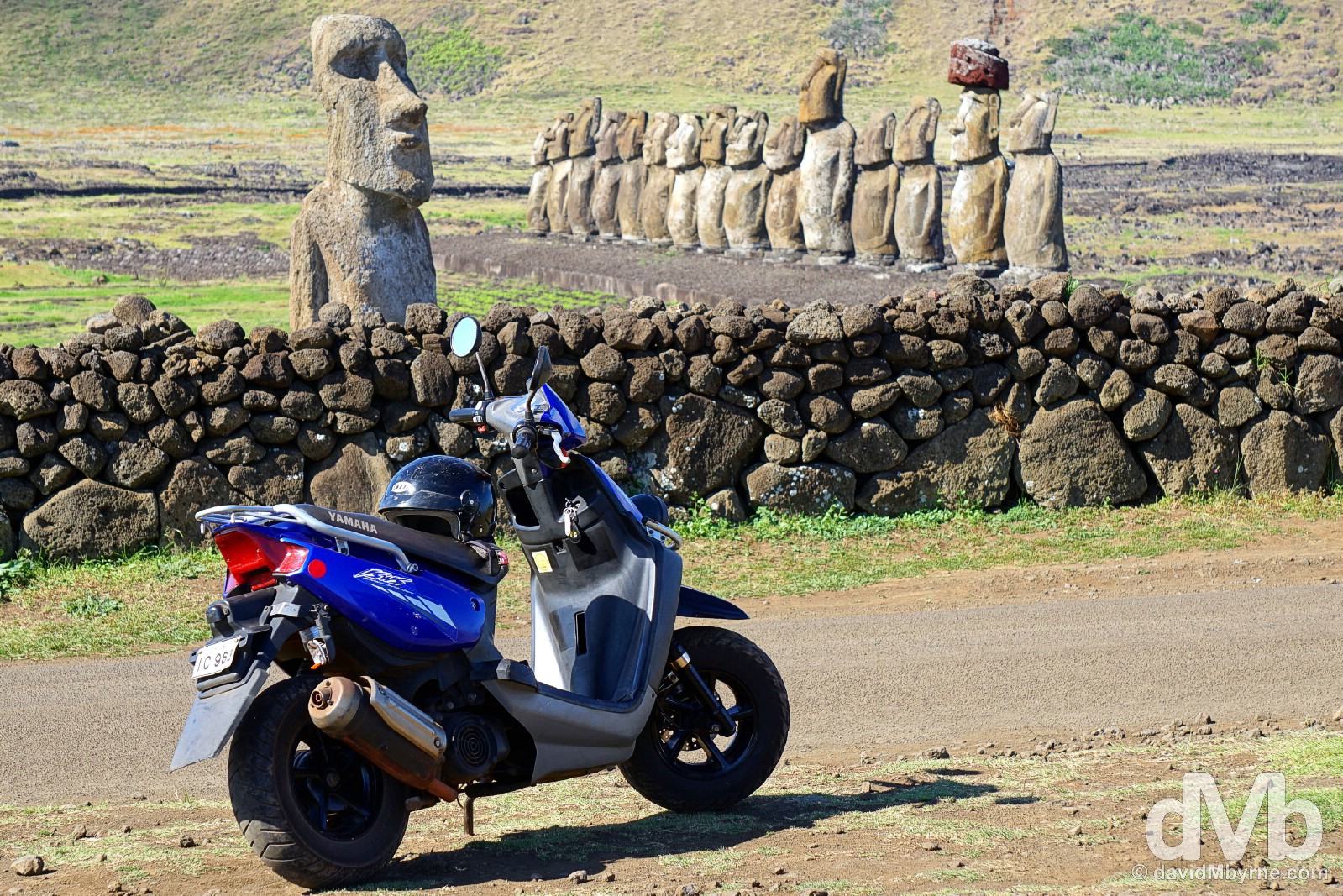
My Easter Island wheels in the car park opposite Ahu Tongariki, Easter Island, Chile. October 1, 2015 || At 20,000 Chilean Pesos (€26) a day, this beast is twice as expensive as a bicycle to hire (yet half the price of anything with 4 wheels) but requires way less than half the energy required of anything with peddles. Plus, it will also get you from A to B many multiples of twice as quick, even heeding the island’s 40-60kph speed limit. All that means it’s a much better option for getting around.
It was a gorgeous day today and I was treated to beautiful clear skies for most of it. The day started with me, once again, passing time in the company the 15 moai of Ahu Tongariki. With the sun out, the setting was gorgeous. I stayed quite a while, finding it hard to move on to hitherto unseen portions of the island. I did eventually move on but not before capturing a few (more) pictures of Rapa Nui’s most spectacular sight.
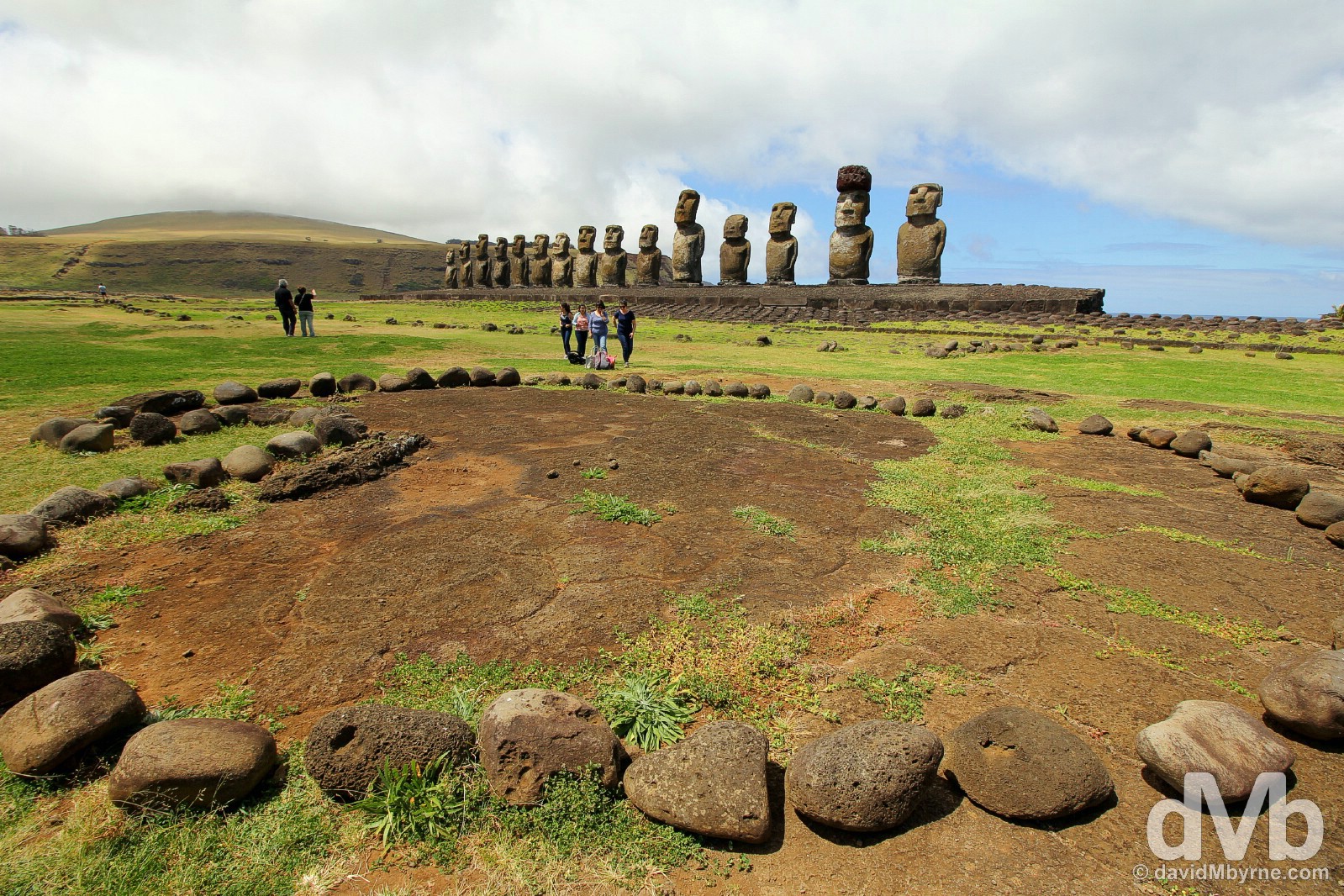
Ahu Tongariki, Easter Island, Chile. October 1, 2015.
More pictures from today at Ahu Tongariki (click to enlarge).
- The 15 moai of Ahu Tongariki, Easter Island, Chile. October 1, 2015.
- Six of the 15 moai of Ahu Tongariki, Easter Island, Chile. October 1, 2015.
- Ahu Tongariki, Easter Island, Chile. October 1, 2015.
- Sunshine illuminates the impressive moai lineup of Ahu Tongariki on Easter Island, Chile. September 29, 2015.
Today was a different kind of Easter Island day; despite the clear skies of the morning & afternoon, there was no sunset. Nope, not even a vague inkling that one was trying to break through the spoilsport blanket of clouds that seemed to come out of nowhere towards the end of the day – playing the Easter Island meteorology game is exhausting. There was also another surprise in store when, & for an hour or so mid-afternoon, and after finally dragging myself away from Ahu Tongariki, I felt like I was back in the Caribbean.
Anakena
You wouldn’t come to Easter Island for a beach holiday but were you to hanker for a swim when here then the sands of Anakena, on Easter Island’s mostly rocky northern coast, would be a damn fine place to do so.

Anakena, Easter Island, Chile. October 1, 2015 || Easter Island’s rocky & irregular coast has only 2 beaches both of which have volcanic & coral sand. This is Anakena, the largest & most accessible of the two (the other beach is Ovahe, a small cove-like beach around the headland from Anakena). Not only is Anakena the island’s best beach but it’s also a place revered by the local Rapa Nui as local lore claims it to be the location where the founding king of Rapa Nui, who led his people to the island by canoe from the Polynesian islands far to the west, first set foot on the island. To say it is pretty is an understatement. The secluded, picture-postcard crescent-shaped bay with golden sand & backed by swaying palm trees is as idyllic as it gets, except for the fact that it could be any beach on any paradise island. What makes it unique to Easter Island is the moai statues found here sitting proudly atop two ahu, Ahu Nau Nau, home to 7 moai (see next picture), & Ahu Ature Huki. The lone squat moai atop Ahu Ature Huki (small spec on the hill to the right of the image) invariably plays second fiddle to the 7 Ahu Nau Nau moai, but it has a story to tell. A trailblazer of sorts, it was the very first moai on the island to be re-erected to a platform; it took 12 (crane-deprived) islanders a mere 18 days to raise the 25-tonne beauty way back in 1955 – any other moai found on an Easter Island ahu these days was erected/restored post this date.
Of the 7 moai originally mounted on Ahu Nau Nau, only 5 survive as complete statues to this day. They are some of the best preserved moai on the island thanks to the fact that they were submerged in beach sand until their restoration in 1978.
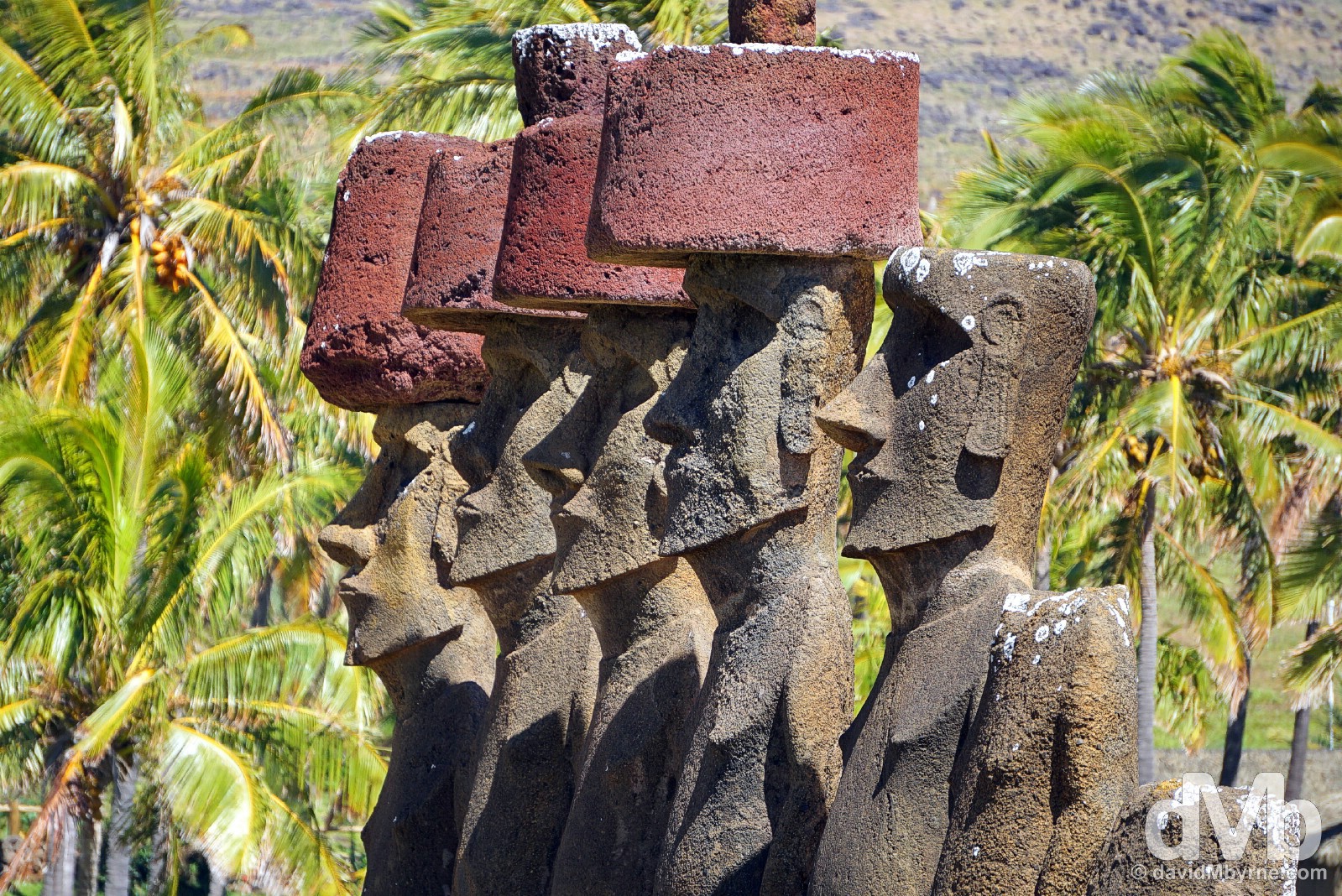
Ahu Nau Nau, Anakena, Easter Island, Chile. October 1, 2015 || All Easter Island moai were carved in a highly stylized manner & even though it is thought the statues were created over a 500+ year period, with production peaking in the 15th century, all share the same characteristics, some of which are demonstrated by the moai profiles of this picture. All have rounded bellies & with arms placed tightly by their sides, so tightly in fact that they can appear armless; all have long-fingered hands that are always placed across their abdomen; and their heads are long & rectangular, with long drooping ears, pointed chins, prominent, angular noses & thin, tight lips.
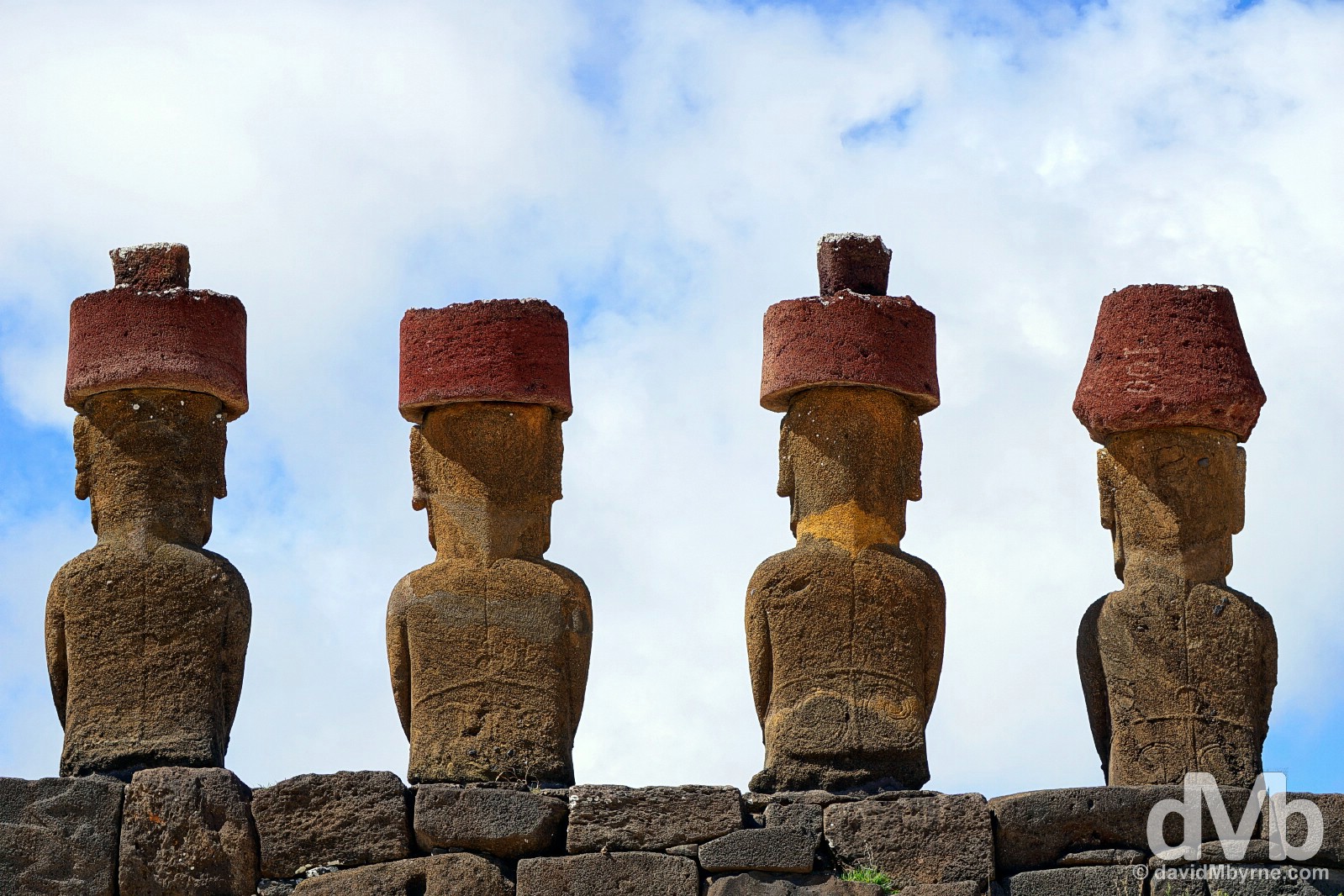
Ahu Nau Nau, Anakena, Easter Island, Chile. October 1, 2015 || Another prominent moai feature is their headgear, the dark-red pukao, cylindrical topknots worn today by only a few of the moai standing on Easter Island ahu, 70 being the figure mentioned in some quarters. Themselves weighing upwards of 12 tonnes, the pukao were quarried in a separate part of the island before being placed on the erect moai. No one knows how this was done, a monumental task even for the hydraulic cranes of today. Likewise, there’s only speculation as to what the topknots represent, though they are likely just a simple representation of a decorative headdress. This is the largest concentration of mounted topknots on the island. Some like their Easter Island moai with topknot, some prefer them without topknot. I’m all for topknots, especially beautifully preserved, deep-red ones like those seen here, so needless to say I loved the moai lineup here at Anakena.
– Pierre Loti, French navel officer, commenting on the pukao of the fallen moai upon visiting Easter Island in 1872.
Leaving Anakena, I continued on my merry way, eventually finding myself standing in front of something of an Easter Island legend, the moai of Ahu Te Pito Kura.
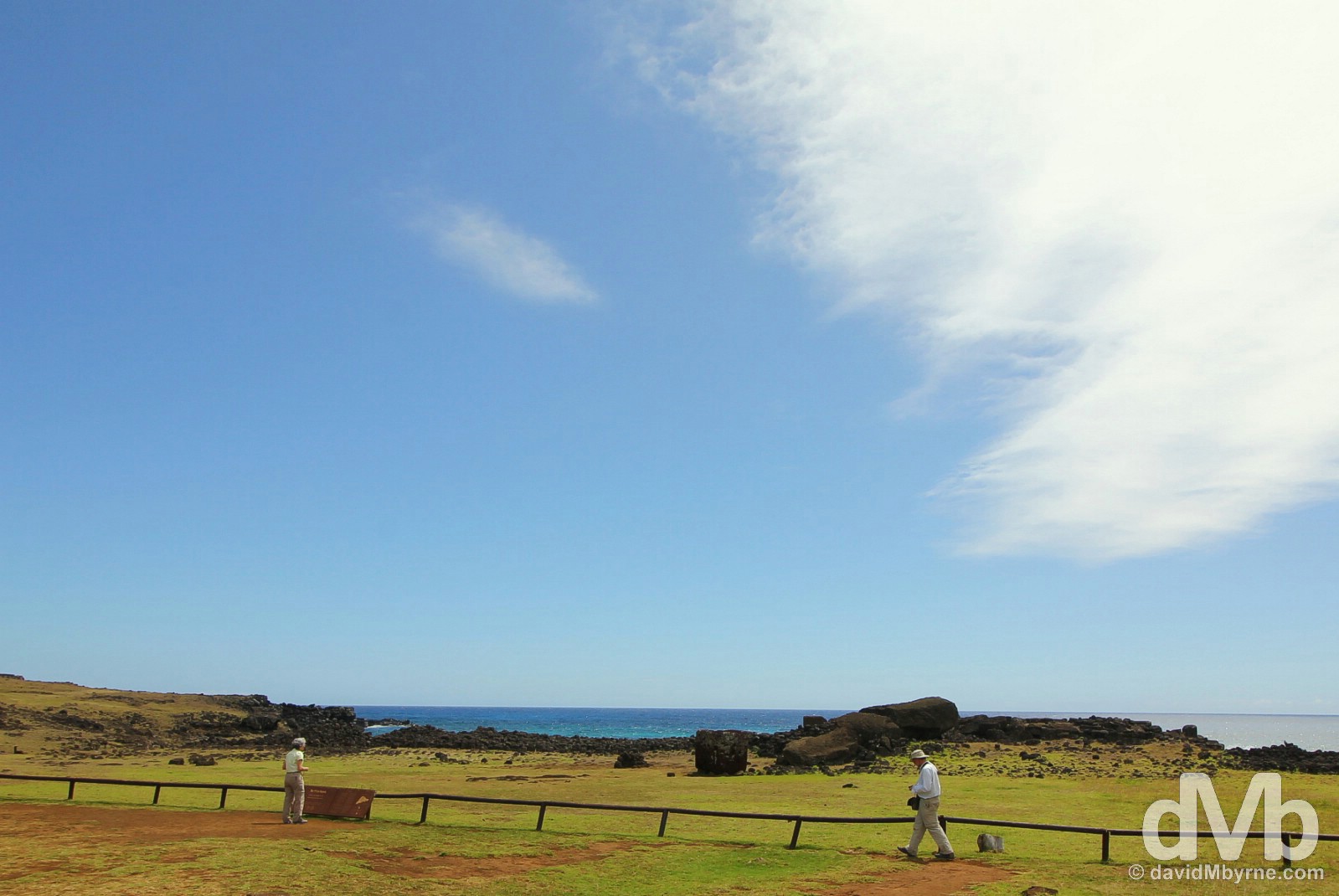
Te Pito Kura, Easter Island, Chile. October 1, 2015 || Not far along the along the island’s northeastern coast from Anakena, the moai at Ahu Te Pito Kura, were it still standing, would tower almost 10 metres above its ahu making it the tallest moai ever propped up on an ahu. Estimated to weigh approximately 82 tons, its topknot/pukao alone, laying some metres in front of the face down moai, is estimated to weigh a cool 10 tons.
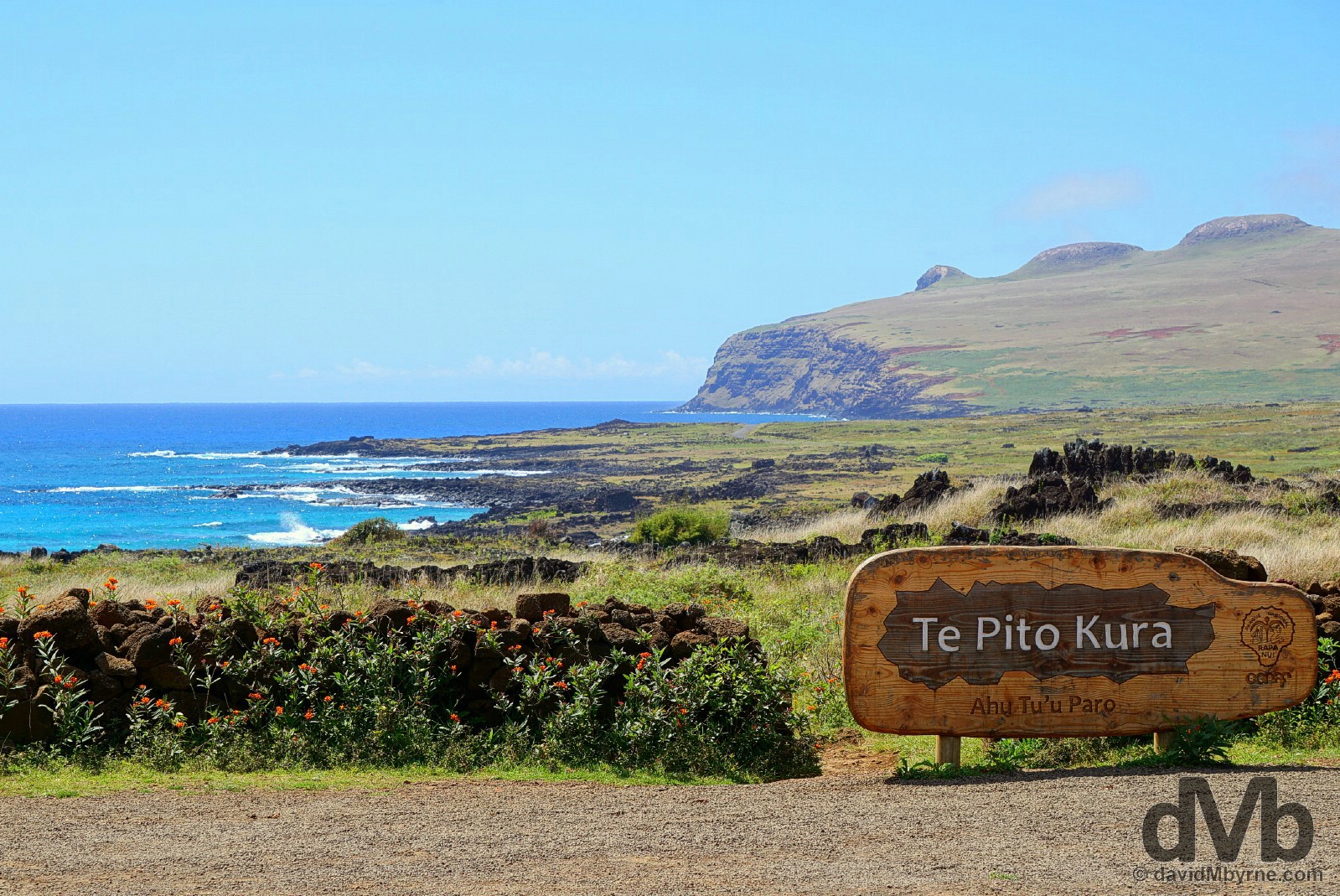
The entrance to Te Pito Kura, Easter Island, Chile. October 1, 2015 || All the archaeological sites dotted around Easter Island are well signposted with most of them having accompanying info boards detailing the site. While it may be small & remote, Easter Island is well set up for tourism; it’s easy to explore and informative.
Leaving the coast and heading to the west, Hanga Roa side for the island via the island’s lone east to west inland road, I next paid a visit to Puna Pau, the quarry for the distinctive red pukao, the moai topknots.
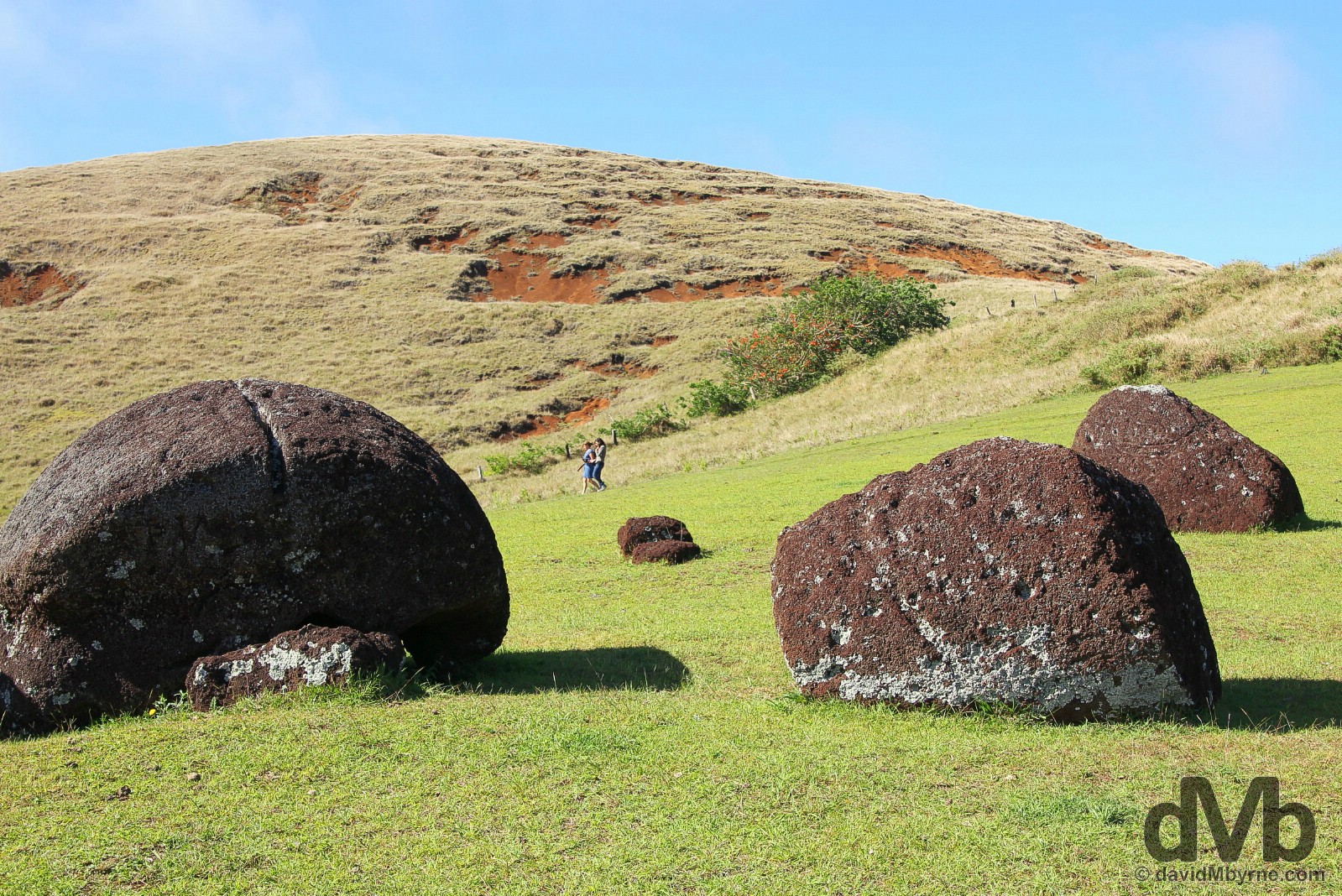
Walking among the unused pukao at Puna Pau, Easter Island, Chile. October 1, 2015 || Puna Pau is a volcanic centre not far from Hanga Roa. It was the location for the moai pukao/topknot quarry, where the distinctive blood-red moai headpieces were carved. Quarried out of a crater, the island’s main source of red volcanic scoria, today about 20 pukao of large dimensions lay dispersed around the small site ready for transportation to their designated ahu, with several of them have showing petroglyphs that represent canoes and tribal signs. While the pukao were sourced & most of the carving was done here at Puna Pau, the carving was only completed once the pukao were transported to their ahu and placed on the head of the moai.
My scooter exploits for this day were almost at an end but not before I revisited the east of the island one more time, back once again to the vicinity of Ahu Tongariki & neighbouring Rano Raraku. Things on this day were about to get real special.
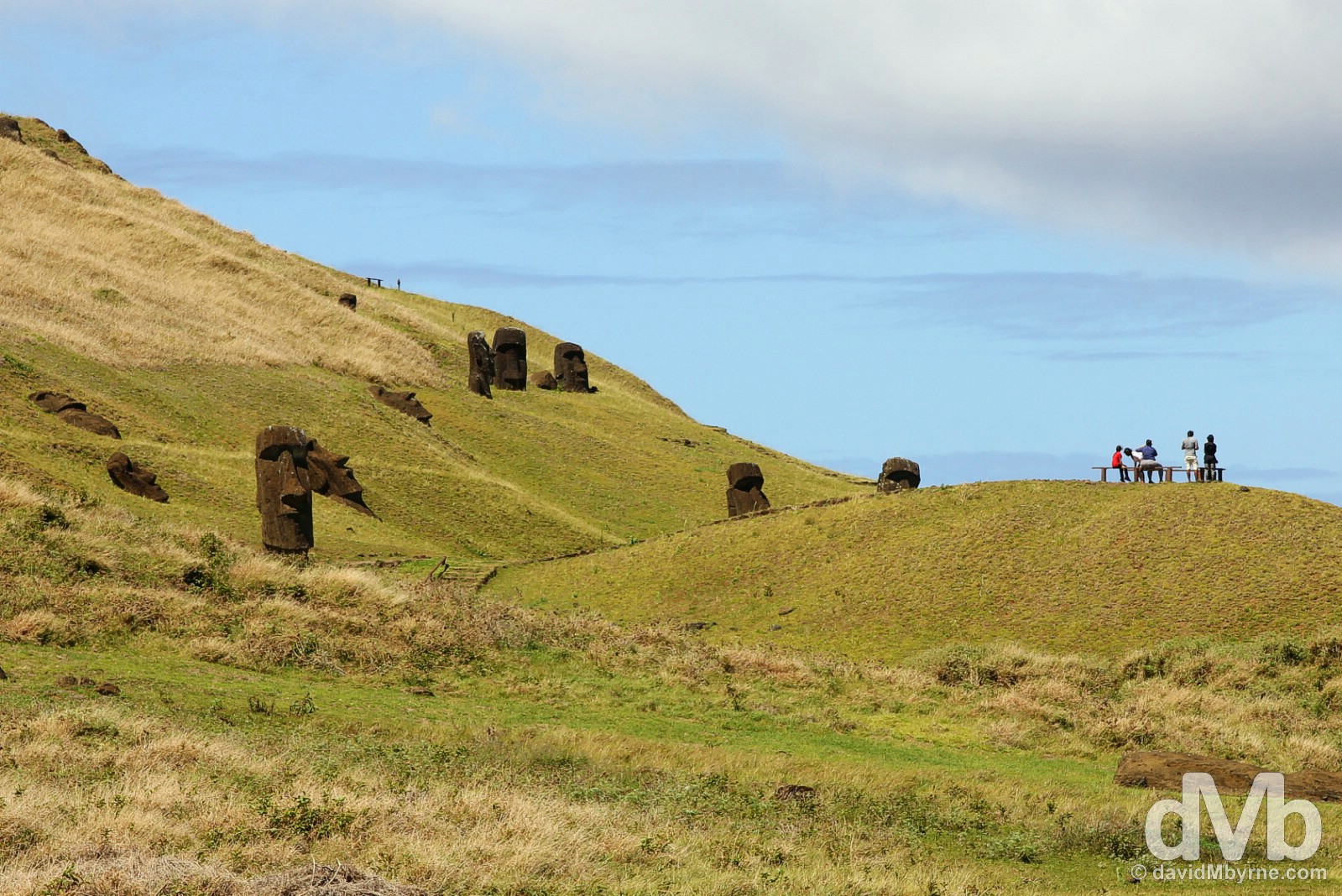
Rano Raraku, Easter Island, Chile. October 1, 2015.
Rano Raraku || The Moai Production Line
On day 3 I visited Easter Island’s Rano Raraku, the tuff (compact volcanic ash) quarry on the east of the island where all Easter Island moai were carved, the island’s moai production line. The location of 397 of Easter Island’s 887 registered moai, it was a gigantic megalithic workshop & today is the biggest monument from ancient times in Polynesia. The site’s slopes are dotted with dozens of moai of various size, orientation & in various stages of completion – some are still attached to the bedrock while others are fully complete, laying here, there & everywhere in pits awaiting transport to their ahu. I revisited Rano Raraku today in the hopes of getting better pictures than I did on day 3, when the conditions were dull & overcast. I wasn’t to be disappointed.
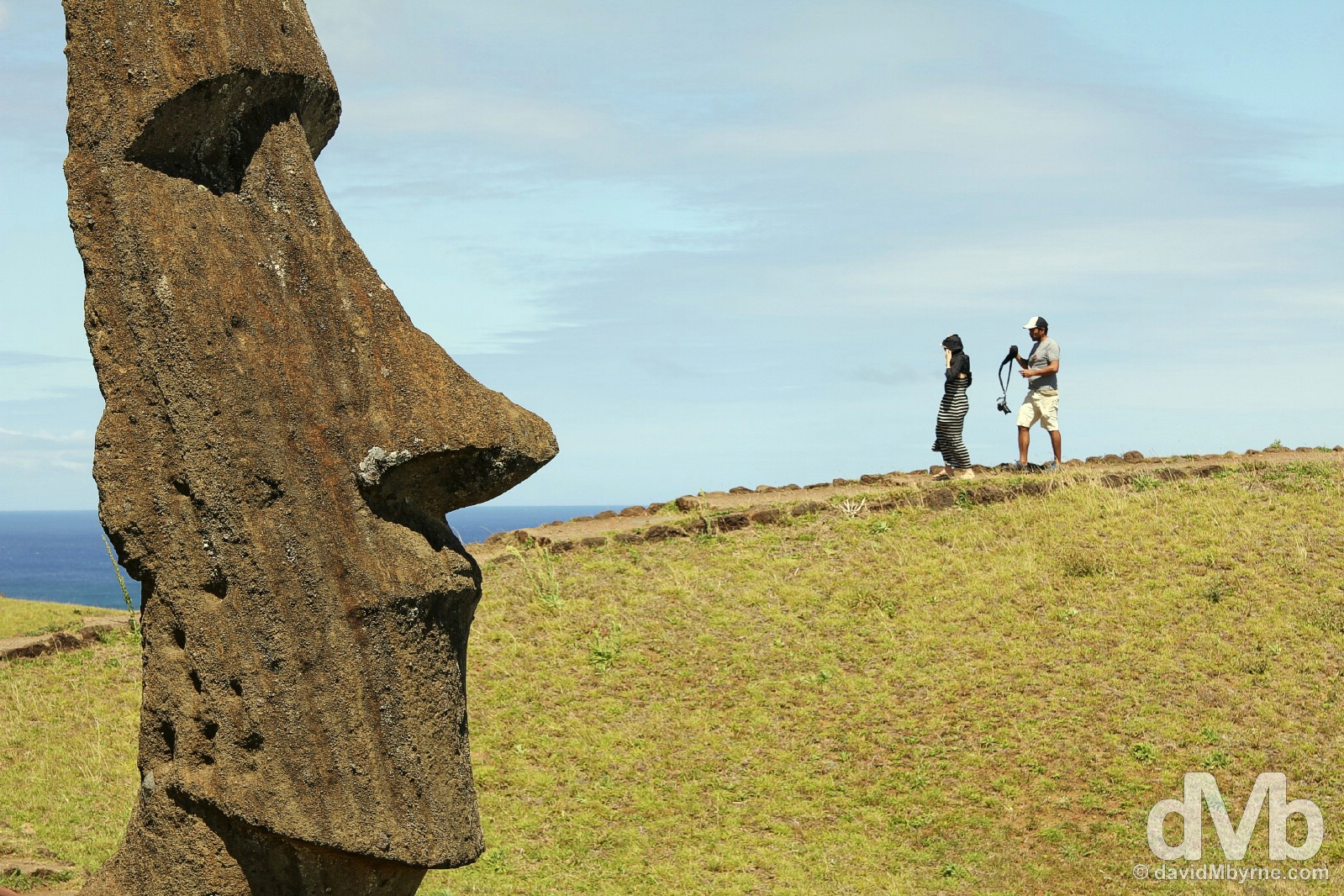
The head of a moai on the outer, sea-facing windswept slopes of Rano Raraku, Easter Island, Chile. October 1, 2015 || All Easter Island moai were chiselled out of tuff rock until they were attached to the bedrock only by a thin keel at their back. When complete, except for their eye sockets which were always fitted when the moai was erect on its ahu, they were freed and slid down the quarry’s slope to be temporarily stored in pits prior to being transported to their ahu. Of course how the 12.5-tonne (on average, some finished moai weigh 80-90 tonnes) statues were transported is one of the biggest Easter Island enigmas (as is how they were erected once they arrived at their platforms). Theories abound, everything from island lore claiming the moai walked to their platforms using their mana (supernatural power or force) to being rolled via wooden rollers, the most widely accepted theory & accepted reason for the deforestation of the island, itself the proposed reason for the eventual collapse of Rapa Nui society itself. This moai, located today well away from the Rano Raraku rock face, was probably completed, or very close to being competed, and was awaiting transport to its designated ahu. Needless to say it went no further and today it just one of many I-never-reached-my-full-potential moai lining a well-trodden path on the outer slopes of Rano Raraku.
• They used to have a name, now they only have a number. 887 moai have been registered to date: 397 reside at the Rano Raraku quarry; 288 were moved and erected on an ahu; 92 lay dotted around the island en route to an ahu; and 110 lay in fragments or in museum collections around the world.
• Only some 5% of moai were carved in material other than tuff – red scoria, basalt & trachyte, the latter harder than tuff and thus more of a challenge to carve. The largest ever basalt moai, Ho’a Hakananai’a, was found in the ceremonial village of Orongo and was pilfered, carted off to Great Britain by the crew of the HMS Topaze in 1868. It presently resides in the British Museum in London, something the Chilean authorities are none too happy about.
• The average moai was a little over 4 metres tall & weighed 12.5 tonnes. The largest ever was 21.6 metre-high El Gigante (The Giant). Estimated to weigh 180 tonnes, it’s unfinished and firmly affixed to the slopes of tuff at the Rano Raraku quarry (viewing it’s massive bulk one can’t help but think that maybe, just maybe, the Rapa Nui had bitten off more than they could chew with this moai). The smallest moai ever erected was a mere 1.3 metres high, while the tallest was 9.8 metres-high. The heaviest moai ever erected on an ahu was an 86 tonne moai at Ahu Tongariki, conveniently the nearest Easter Island ahu to the Rano Raraku quarry.
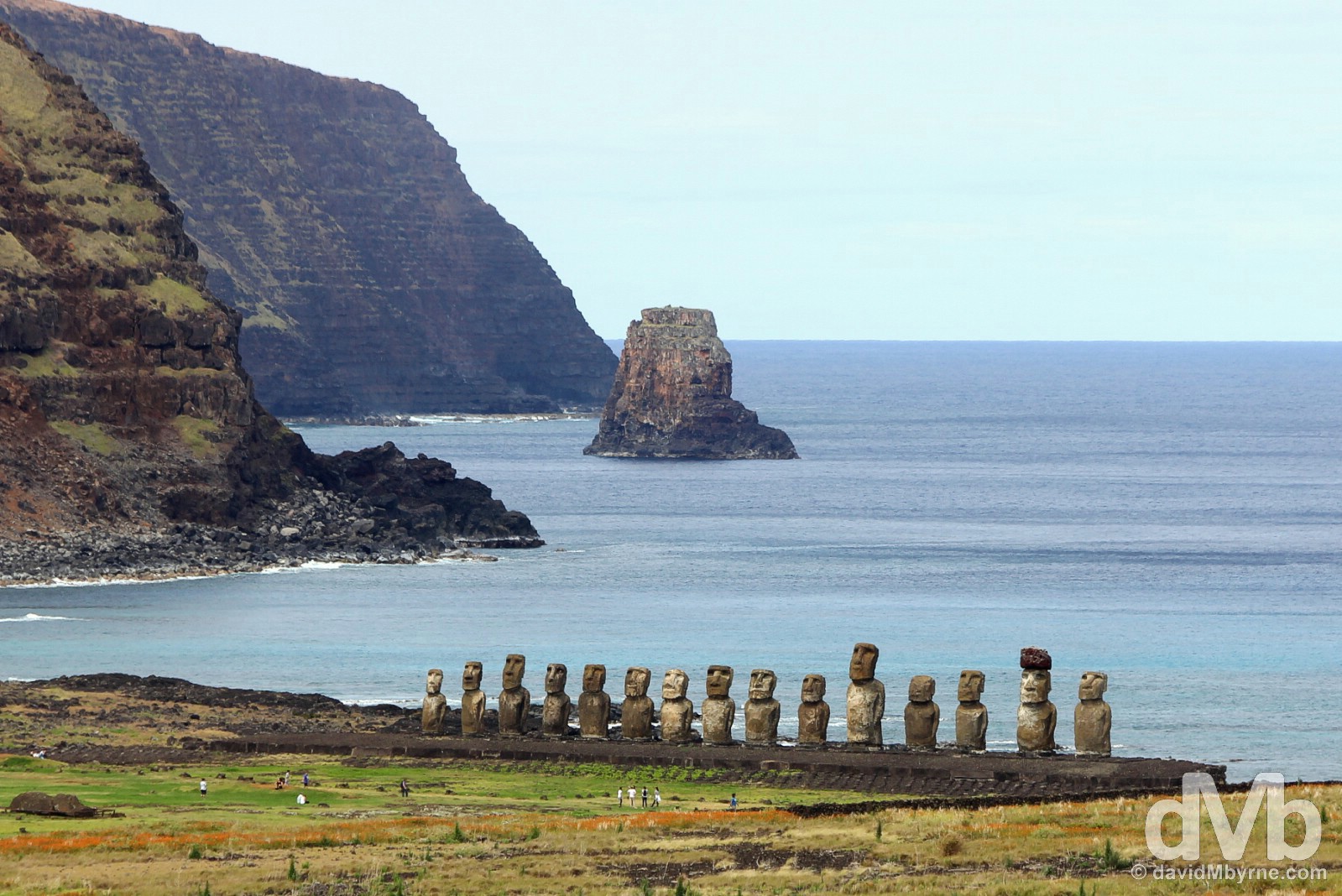
My very first (distant) sighting of Ahu Tongariki on my third day on Easter Island during my first visit to the slopes of the Rano Raraku quarry located some 2-3 kilometres from Ahu Tongariki itself. Easter Island, Chile. September 29, 2015.
Rano Raraku is a volcanic crater of tuff, the slopes on either side of which were used as an open-air moai carving workshop. Thanks to a designated trail, the outer slopes see the vast bulk of the visitors but moai are to be found on the inner slopes of the crater too, a sheltered, beautifully peaceful place where seemingly few venture and a place that’s home not only to moai but also to a picturesque crater lake. I explored the crags & hills of the inner slopes today, making friends with a few of the permanent moai residents as I did.
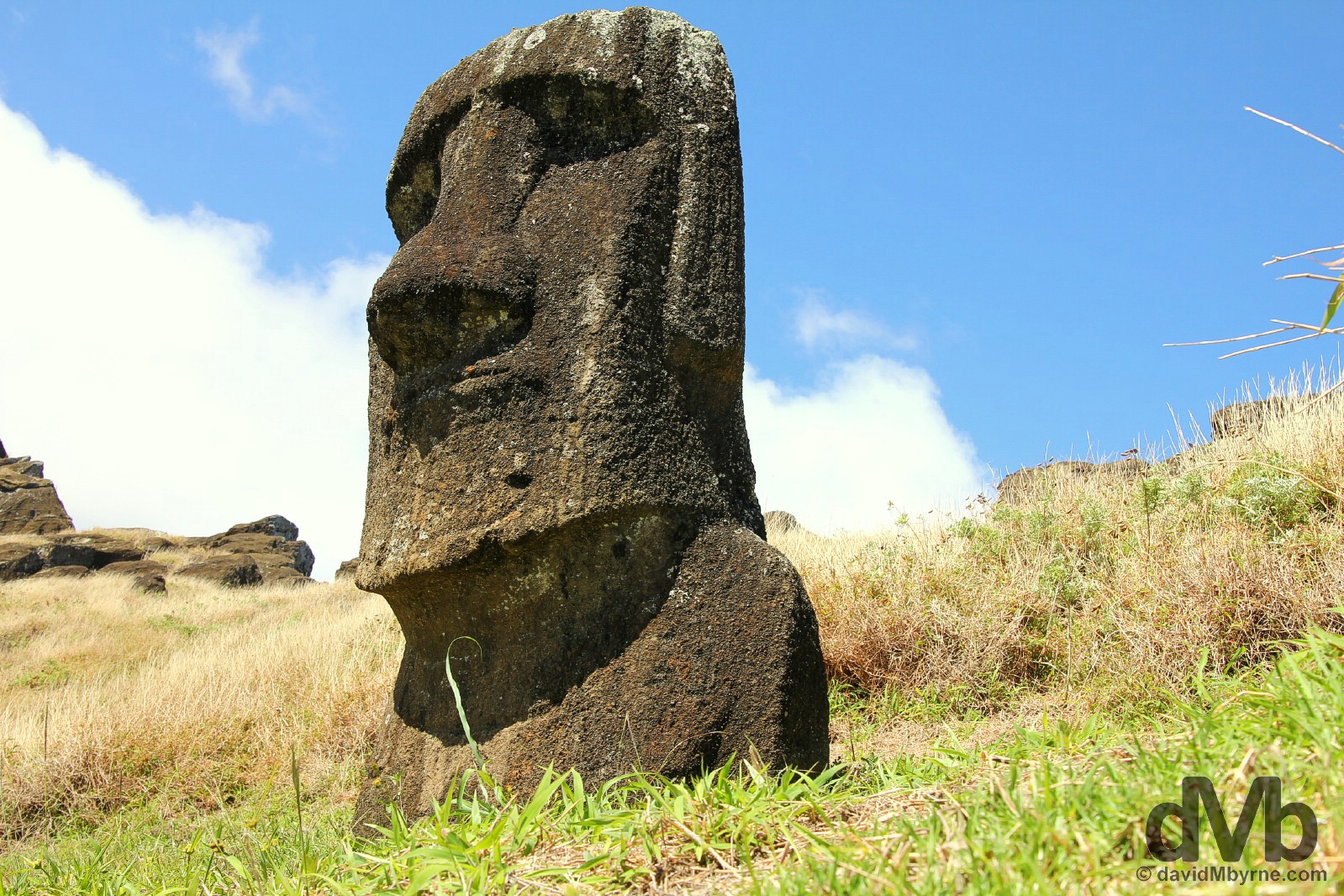
A moai in the crater of Rano Raraku, Easter Island, Chile. October 1, 2015 || Most of the moai heads in Rano Raraku do have bodies. They are full statues buried or encroached upon by surrounding soil over the years (think iceberg, with only a small portion visible). Walking among these moai figures was like being in some sort of Neolithic statue theme park, except it was real. Very real. I also had the whole scene, one of the most gorgeous places I’d ever been to, all to myself. It was beyond awe-inspiring, oh-so memorable. But little did know it was only going to get better.
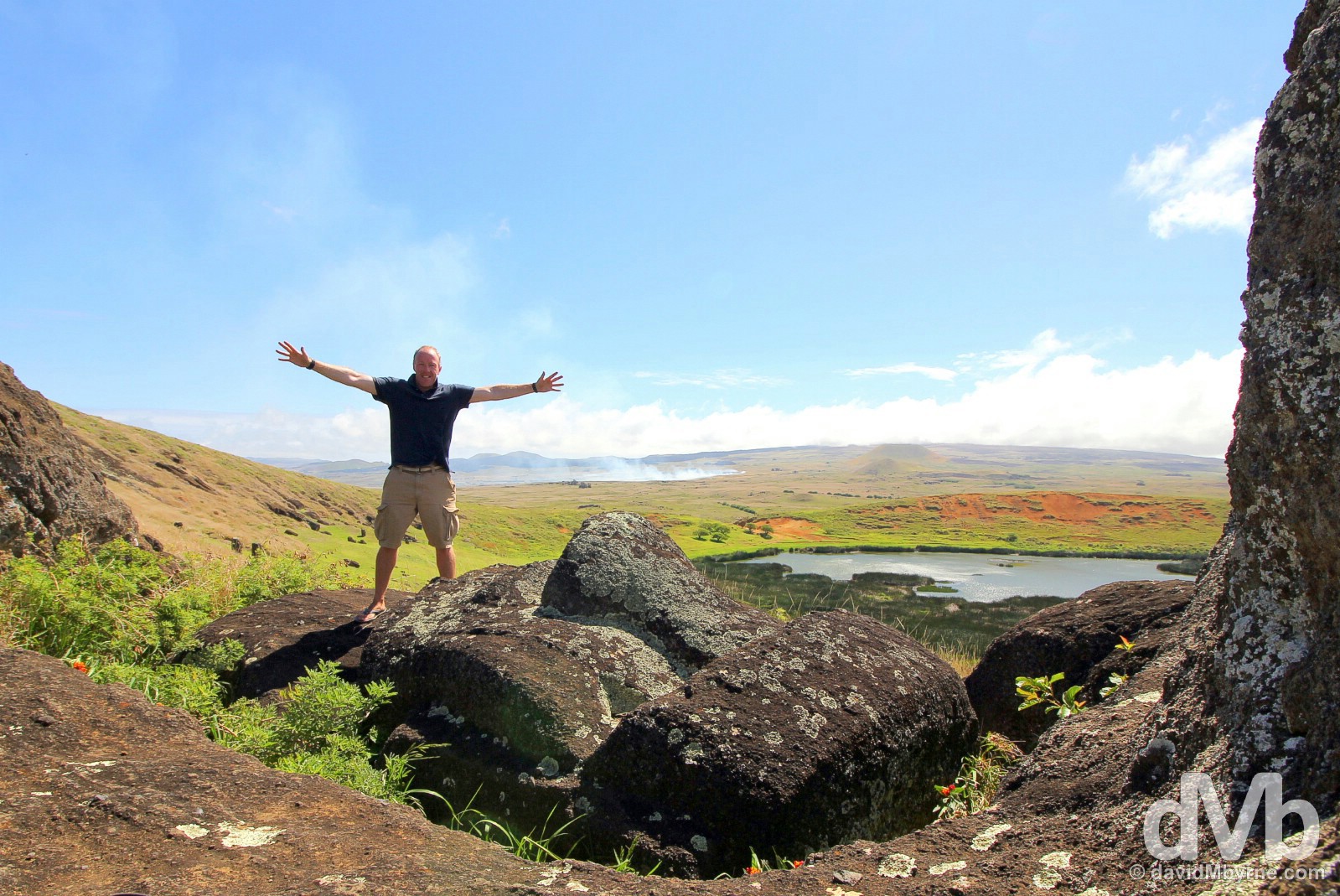
Rano Raraku, Easter Island, Chile. October 1, 2015 || I clambered up to the rim of the Rano Raraku crater, not sure if I was supposed to – there was a trail, albeit an obscure one. The very last portion of the accent, to the very rim of the crater itself, saw me pull myself up onto a rock to access the ledge. Once there I looked down, only to realise I was standing on the massive face of an unfinished moai. I stopped dead. I was frozen. It was an amazing moment and as I lived it the obvious kept coming to the forefront of my thoughts – how the hell, upon completion, did the Rapa Nui ever propose getting the thing down (before reminding myself that they’d somehow managed it many, many times already)?
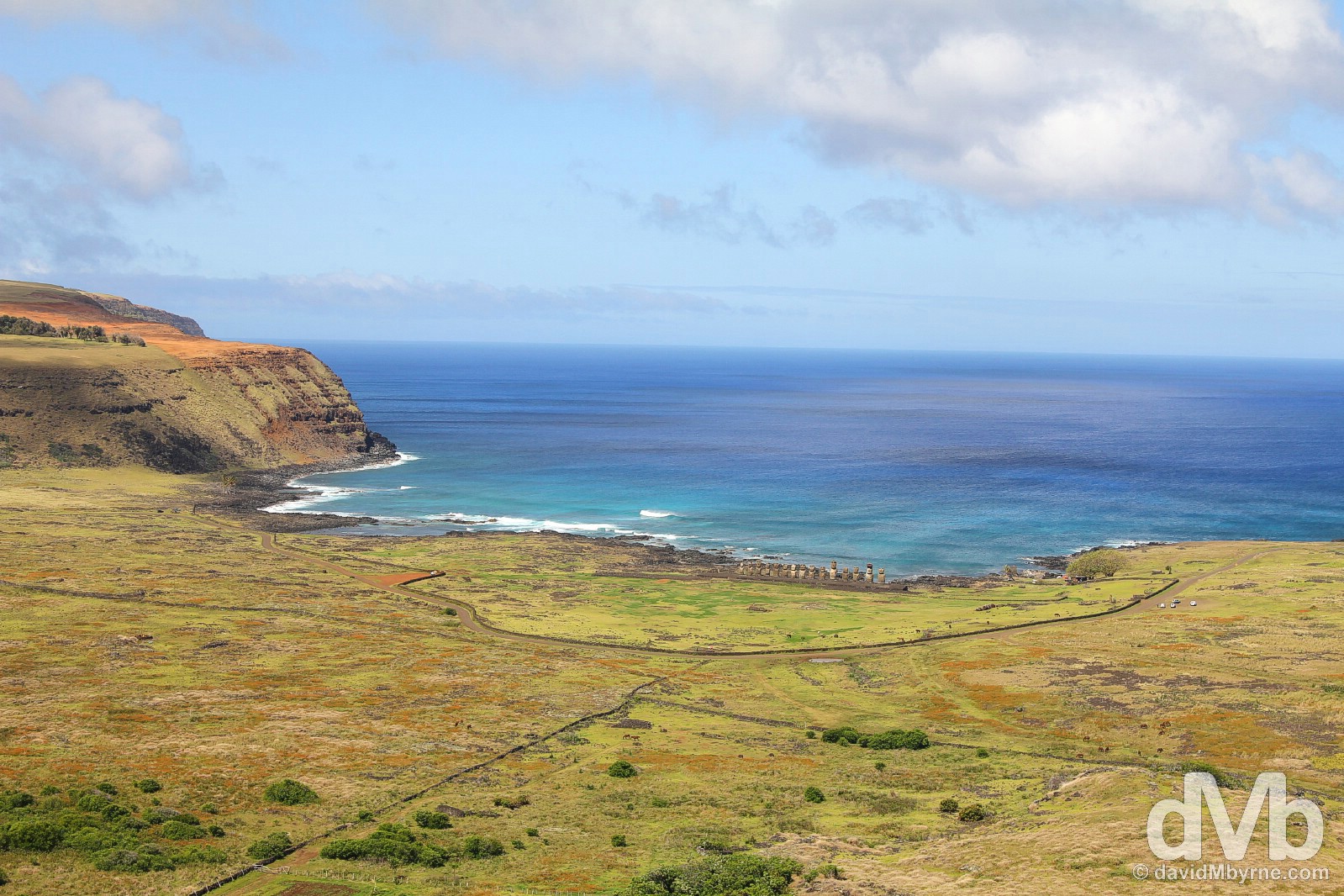
The view from the ridge of the windswept Rano Raraku crater, looking towards the east of the island and the 15 moai of Ahu Tongariki, was something special (everything about today at Rano Raraku was). Having a massive unfinished moai up here with me was just the icing on the cake. Easter Island, Chile. October 1, 2015.
My day was done once I came down, both literally & metaphorically, from my second visit to Rano Raraku. I’ve two sleeps, one full day, left on Easter Island. I’ll have my Yamaha for the duration. I’ll also have an Easter Island to-do list, now full of ticked boxes. Completing the list only took 5 days. It could be done quicker – a lot quicker – but this is no place to be rushed. Two sleeps. Umm, I guess it’s better than only one.
Day Six
Date || October 2, 2015
Location || Hanga Roa, Easter Island, Chile ( )
)
I was up before the sun this morning. Not only was I up before the sun but I had made my way, in the pre-dawn darkness & drizzle, to the other side of the island from Hanga Roa in a bid to get to Ahu Tongariki, the island’s de facto sunrise location, in time for the sun to show. I needn’t have bothered. It was a nasty, cloudy start to the day & even though my optimism en route convinced me that conditions would improve, they didn’t. Not for sunrise and not for any part of the day thereafter, day 6 on Easter Island & my last full day savouring its wonders. However, it wasn’t a total bust as I did get to spend some time – 20 minutes or so – alone with the 15 Ahu Tongariki moai before others turned up to spoil the solitude & to join me in being disappointed by the sunrise no-show. For those 20 minutes it was just me, 15 towering moai & the sound of the Pacific Ocean crashing in the distance through the darkness. It was surreal and I felt all alone on the face of the planet. My camera stayed put in my bag.
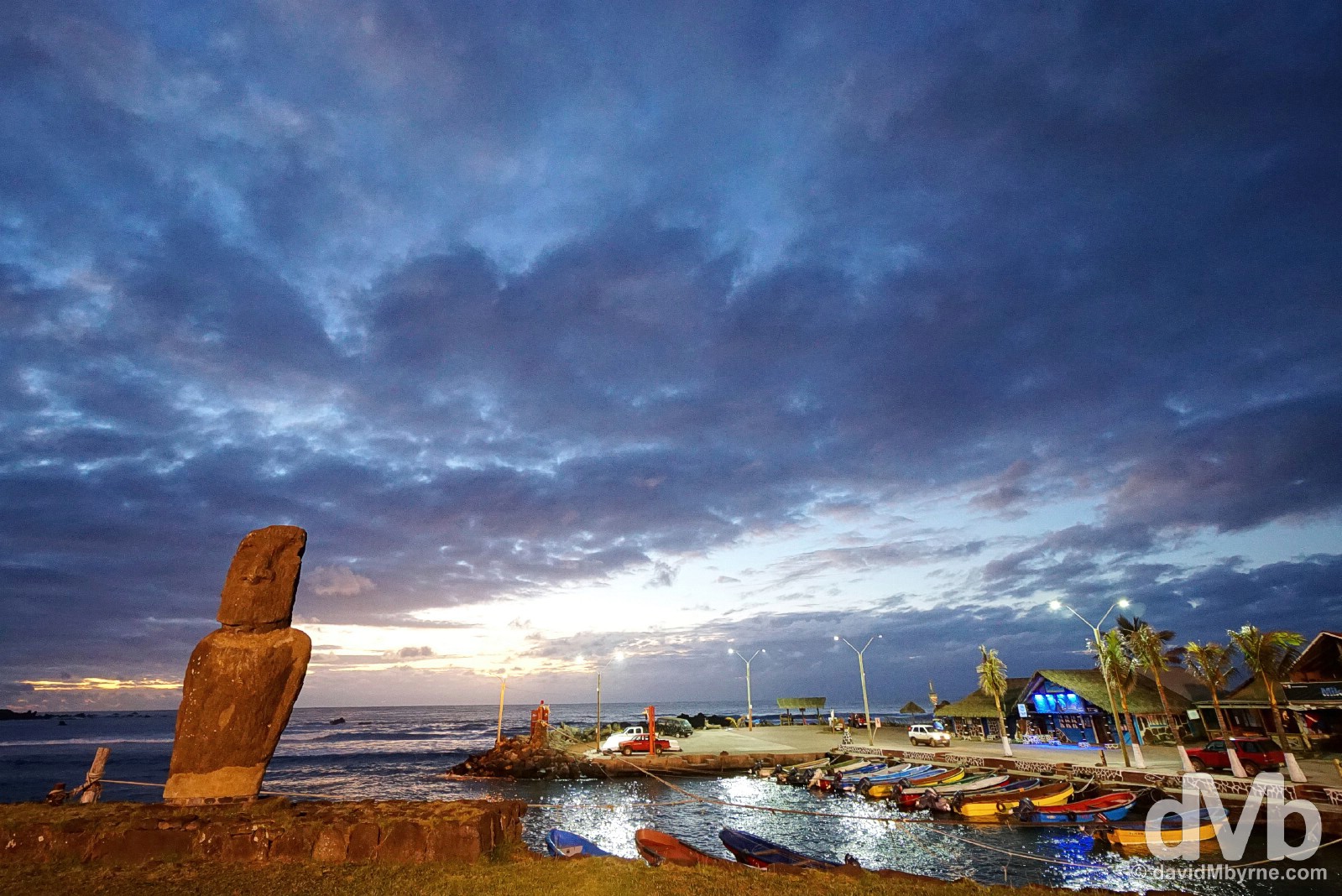
Dusk at Hanga Roa harbour, Easter Island, Chile. October 2, 2015 || Just like sunrise, sunset today wasn’t up to much either. But I was still there in Tahai on the outskirts of Hanga Roa just in case, & just like I have been every night I’ve been here, to see whatever there was to see of my sixth & last Easter Island sundown. Again my camera stayed in my bag. I took it out on the way back to my guesthouse when passing Hanga Roa’s quaint little harbour, somewhere I’ve passed many times this week & somewhere where you’ll find the weathered Ahu Tautira, home to the only moai in the town proper.
The rest of today, between sunrise & sunset, was slow. I took another spin around the island, heading east again along the southern coast road and returning via the central road, a 40 kilometre loop. I drove it with very little urgency – if the Yamaha had gears (she doesn’t) I doubt she’d have been taken out of first.
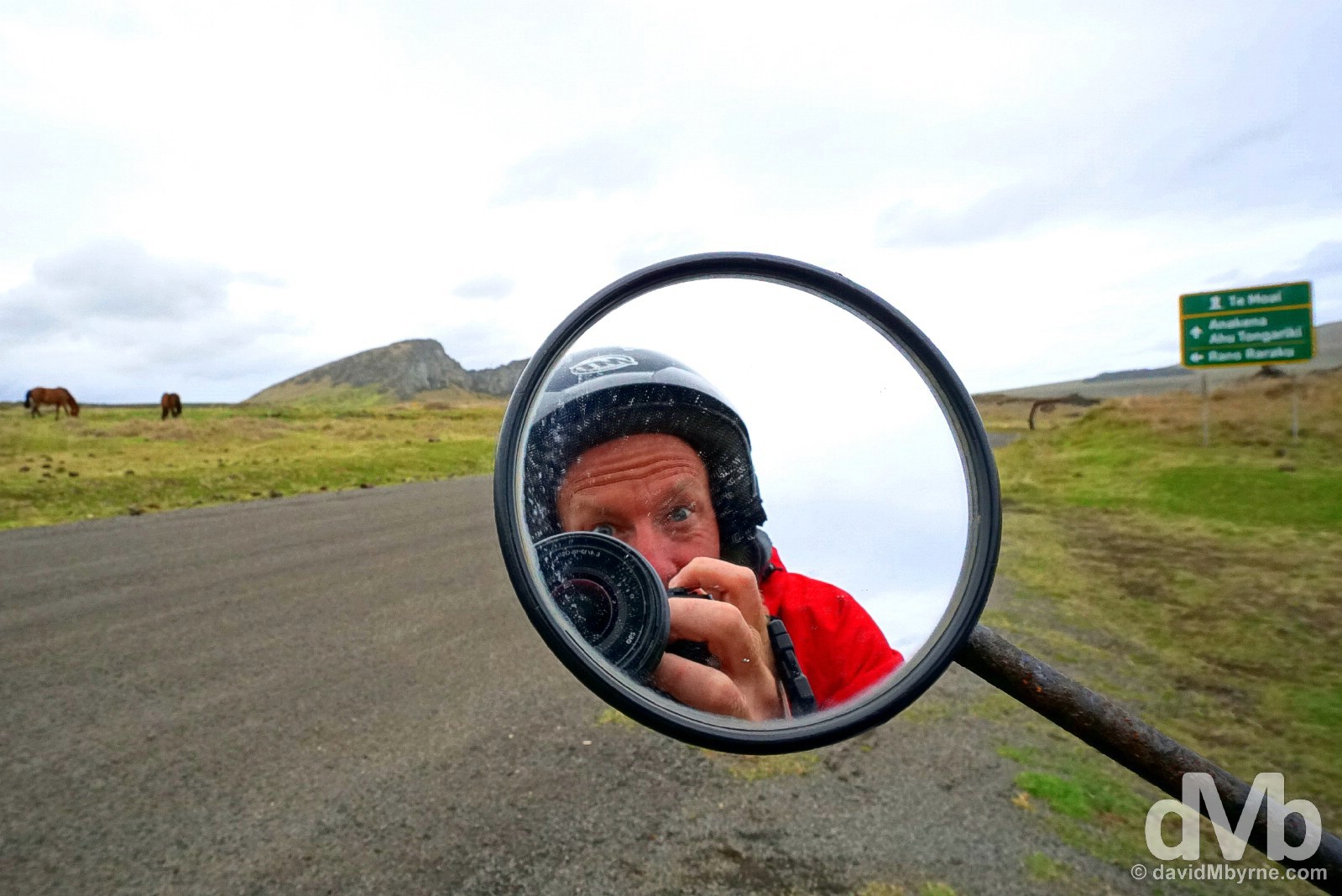
Southern coastal road pit stop on Easter Island, Chile. October 2, 2015 || Me again, this time on the roads of eastern Easter Island. Sharing the frame with me here is some of the many horses that roam all over the island (along with the cows) and in the distance is the upper reaches of the moai quarry of Rano Raraku.
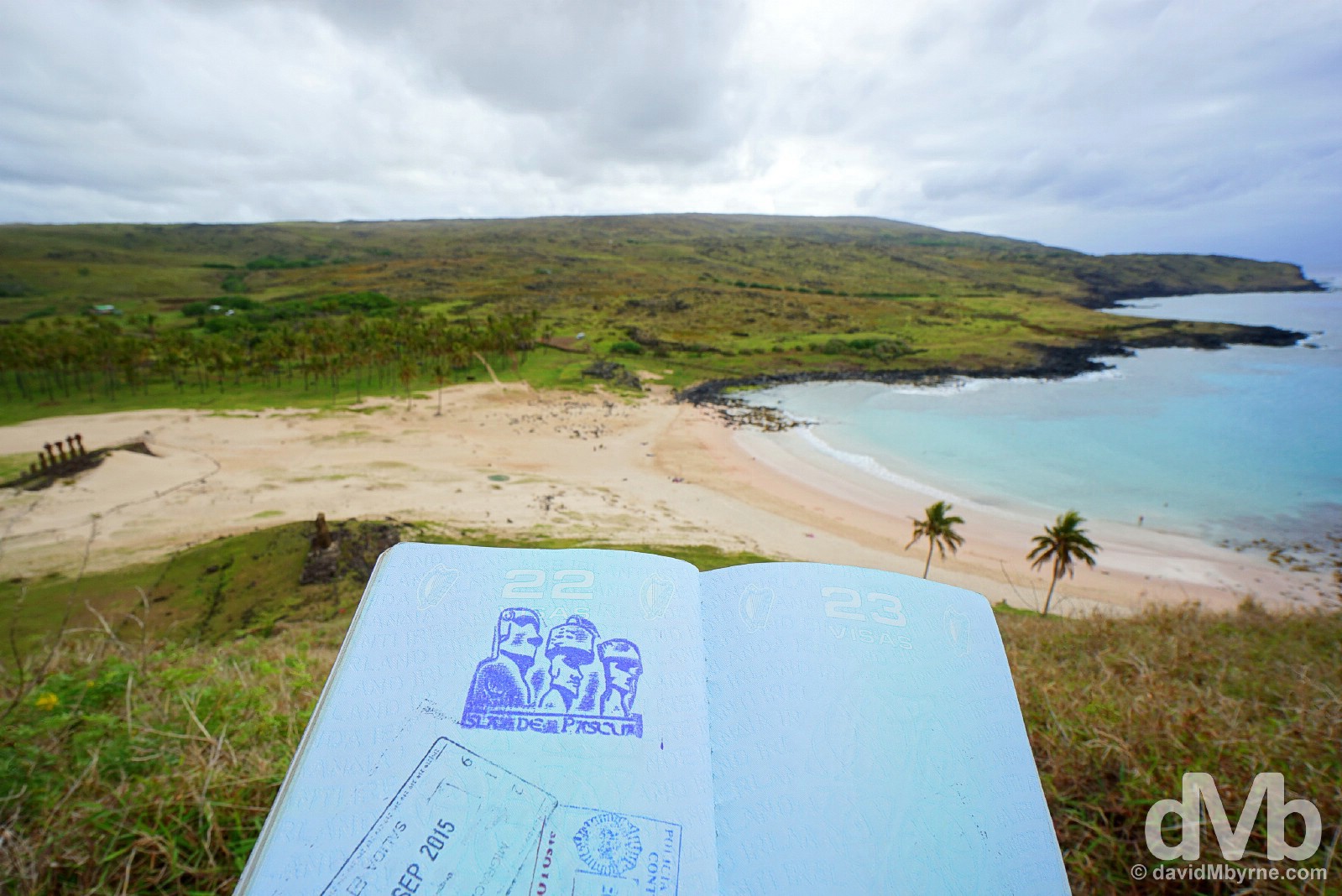
Passport stamp overlooking Anakena, Easter Island, Chile. October 2, 2015 || It’s not the island’s remoteness. It’s not the mysteries or enigmas associated with it. It’s not even the iconic moai statues. Nope, the real reason people venture to Easter Island is to get the stamp. Available in the tiny Hanga Roa Post Office to anyone who presents their passport (or just a piece of paper for that matter), the Isla de Pascua (Easter Island in Spanish) stamp is the ultimate Rapa Nui keepsake. This is mine taking pride of place on page 22 of my passport. It was acquired today before hitting the road and is seen here as photographed from atop a hill overlooking the beach at Anakena, somewhere that looked so much more inviting when bathed in yesterday’s sunshine.
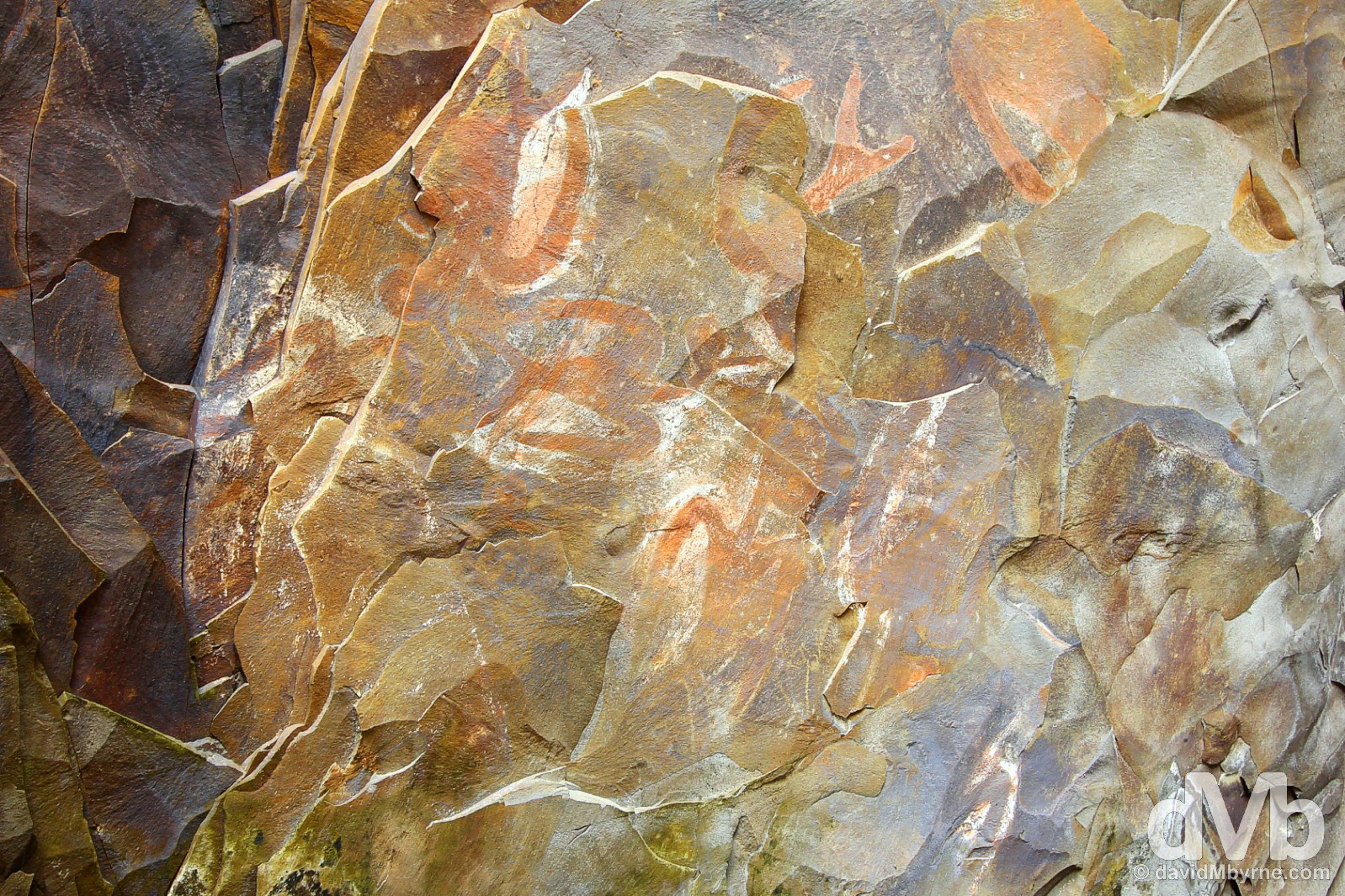
Ana Kai Tangata, Easter Island, Chile. October 2, 2015 || Today was a good indoorsy kind of day, a good day to visit a cave. I’d visited Ana Kai Tangata before, on day 2, but I returned today to photograph its rock art, one of the finest examples of such artistic expression on the island. Along with rock carving/petroglyphs, rock painting was another way Rapa Nui culture used to express their beliefs. Carvings are abundant on the island, paintings less so with the art here in the Ana Kai Tangata cave on the outskirts of Hango Roa the most prominent place left on the island to view pictographs (although they are hard to spot & even harder to decipher without the aid of a guide).
The overcast conditions mirrored, or maybe even enhanced the somewhat melancholy demeanour I carried around the island with me today, the result of knowing the Easter Island end is nigh. I’m outta here tomorrow, but not before I give sunrise at Ahu Tongariki another chance to impress in the morning. My alarm is set & I’ve another drive in the darkness along the island’s southern coast to look forward to. Here’s hoping at the end of it that there’s something to see (at this stage I’m not even all that interested in photographing it). It’s been great so far so I can’t really expect too much more from Easter Island. That said, a sunrise over Ahu Tongariki would be a nice send-off.
Day Seven
Date || October 3, 2015
Location || En route to Santiago, Chile
And so it is done. I knew this day, this moment, would come. It had to happen eventually. My time on Easter Island has come to an end. We’re not long airborne and I’ve just taken my latest last bittersweet glimpse of the island. It’s over my left shoulder getting smaller and smaller as we climb higher and higher.
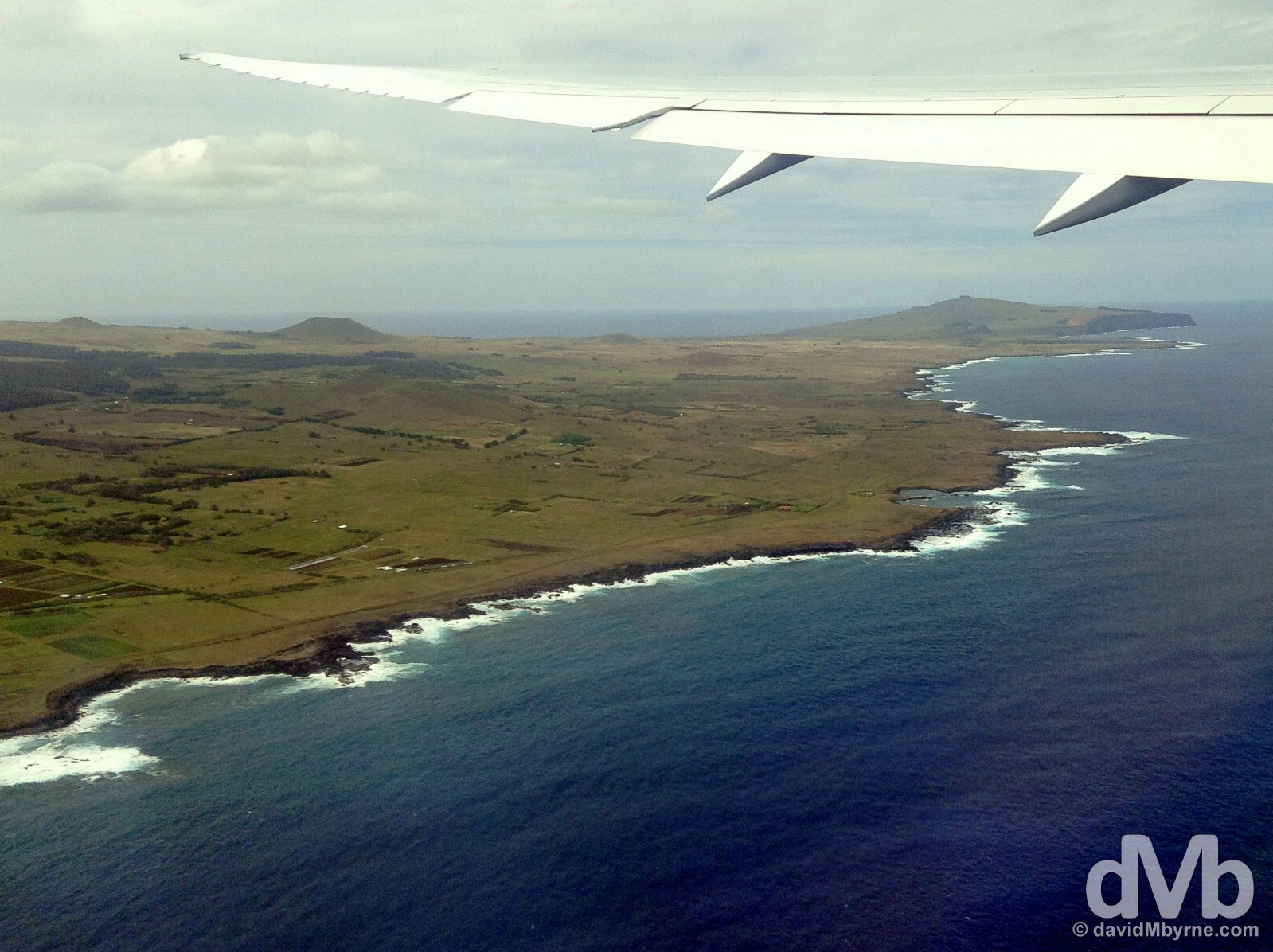
An iPod shot of the southern coast & eastern portion of Easter Island as seen after take-off of LAN flight LA842 en route to Santiago, Chile. October 3, 2015 || I’ve just taken off & I’m en route back the South American mainland. My 7-day holiday within a holiday – South America – within a holiday – my general being – is over. It was an amazing last week experiencing a truly amazing, enchanting location, one big outdoor museum, the remnants of a unique cultural phenomenon that thrived in isolation on a small island in the middle of the vast Pacific Ocean. I knew pre-arrival that Easter Island was going to leave an impression. I just underestimated how much of an impression. I’m going to miss the island but god only knows I’m taking enough media – both in digital & print form – with me to remind me of a location like no other.
Before I left the island, I did get a nice send-off. There was a sunrise this morning and it was pretty, as sunrises tend to be. Throw Ahu Tongariki into the mix and one is bound to be impressed.
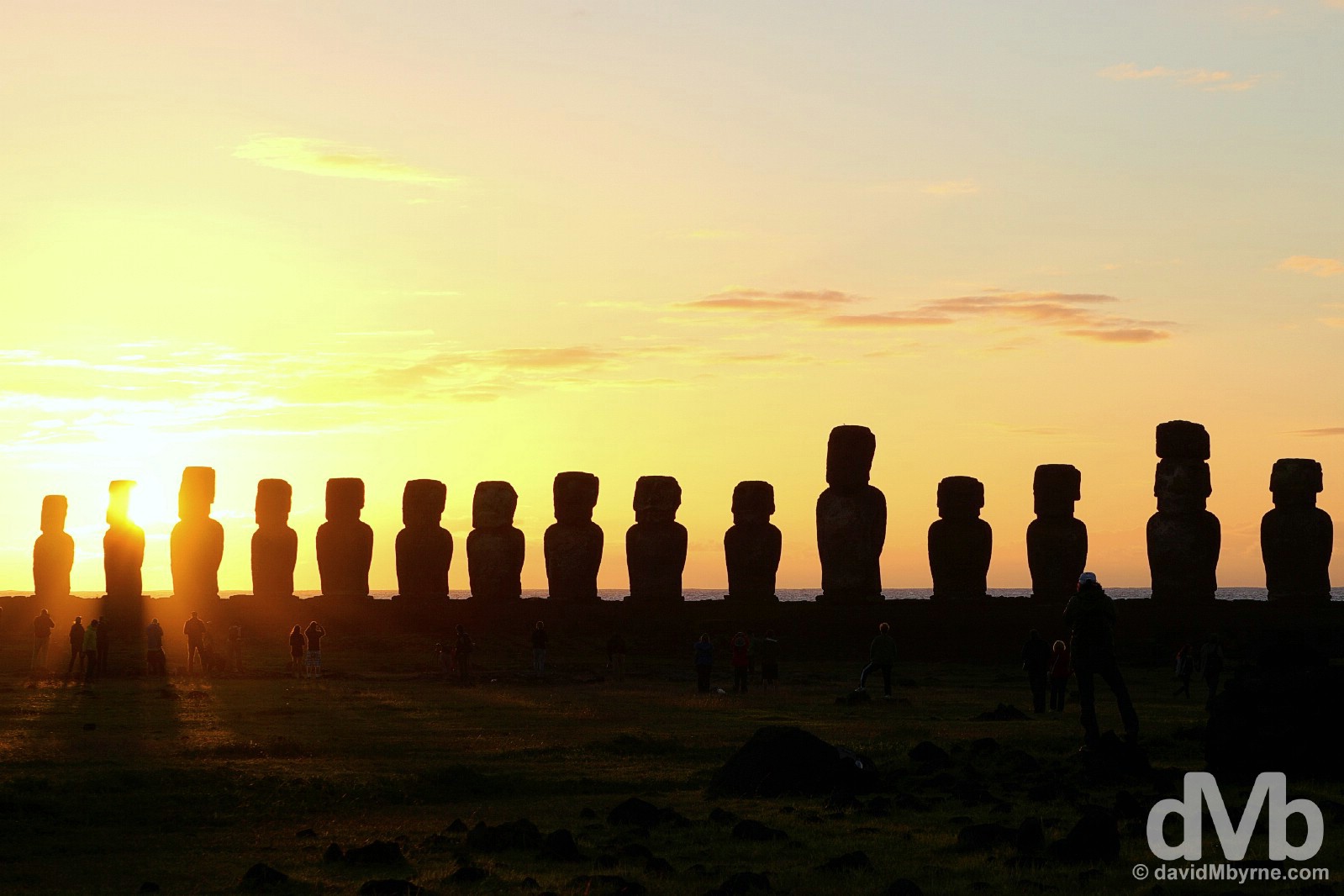
Sunrise at Ahu Tongariki, Easter Island, Chile. October 3, 2015.
I’ll be honest, I was happy to just take in the spectacle this morning, happier to savour it than photograph it; I didn’t even bring the big camera, opting only for the smaller one to keep me company on this my sixth & final visit to Ahu Tongariki. But I did take a few quick captures as I was standing there first waiting for the sun to appear and then watching it slowly rise behind the moai of Ahu Tongariki.
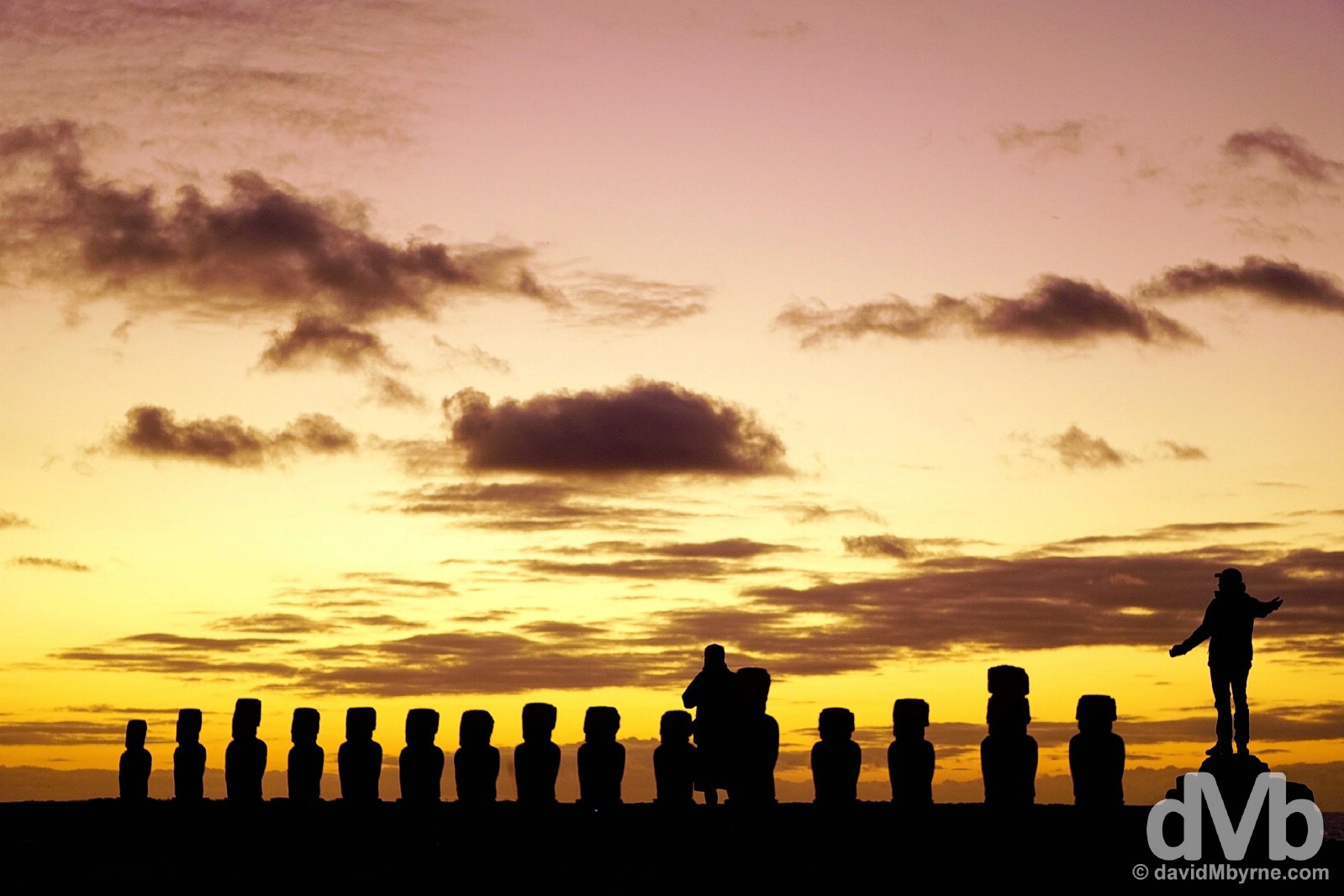
Awaiting sunrise at Ahu Tongariki, Easter Island, Chile. October 3, 2015.
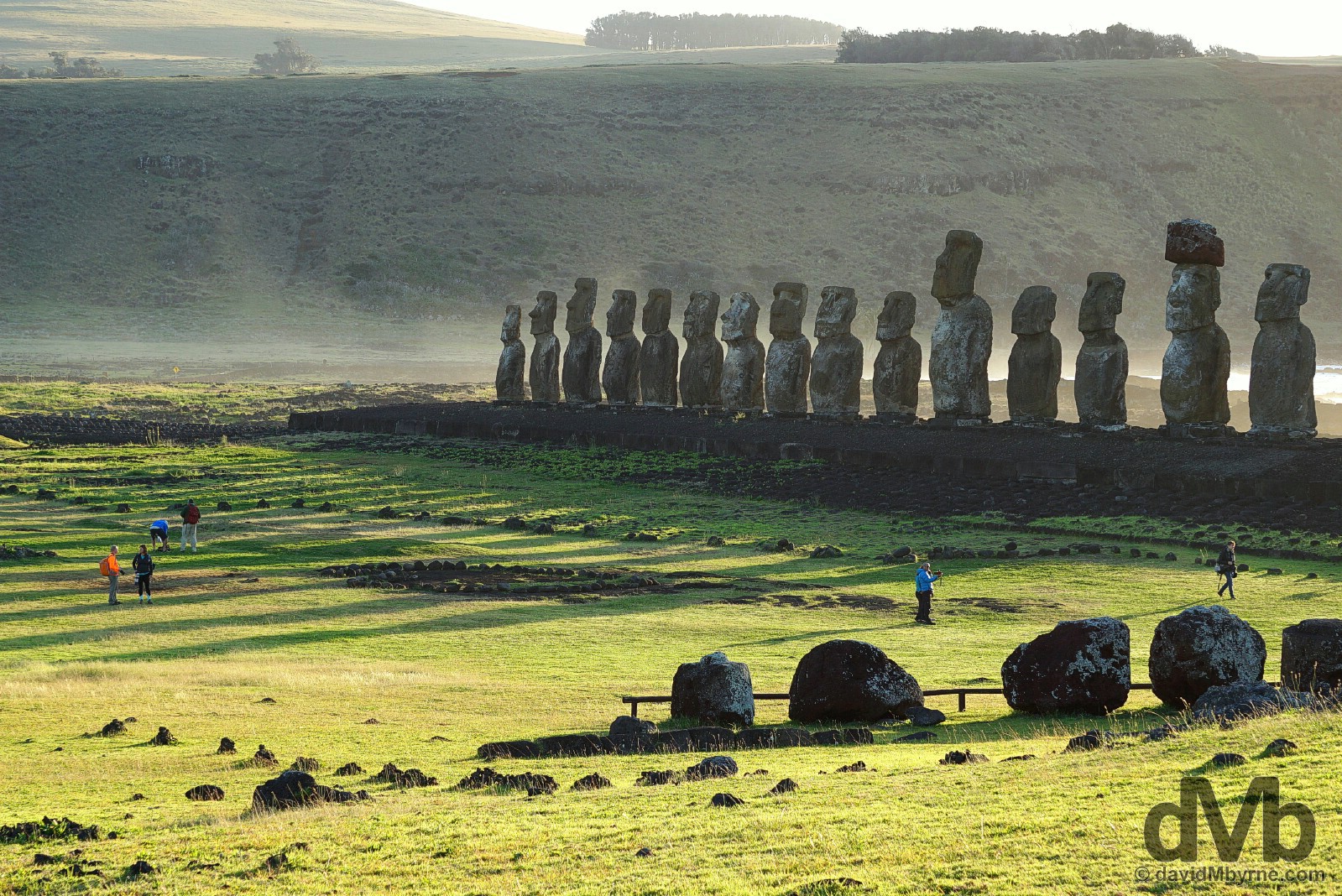
When the sun rose, the shadows the moai of Ahu Tongariki cast were awesome. A nice send-off indeed. Post sunrise shadows at Ahu Tongariki on Easter Island, Chile. October 3, 2015.






